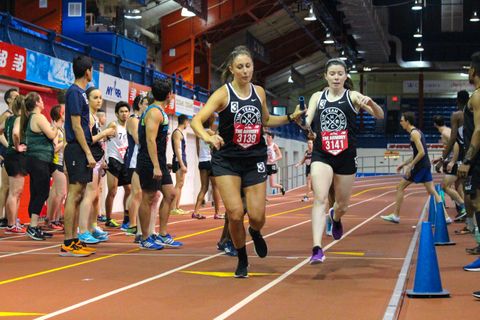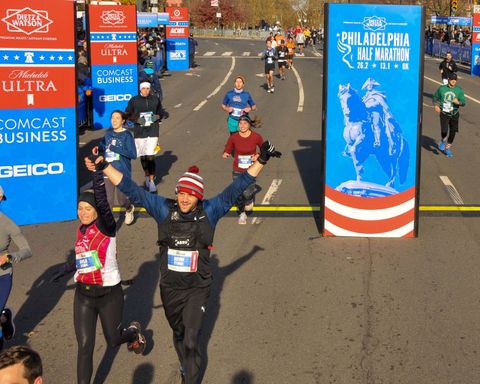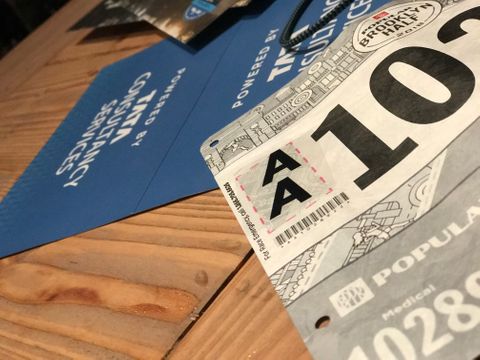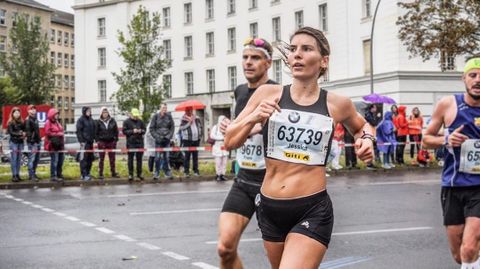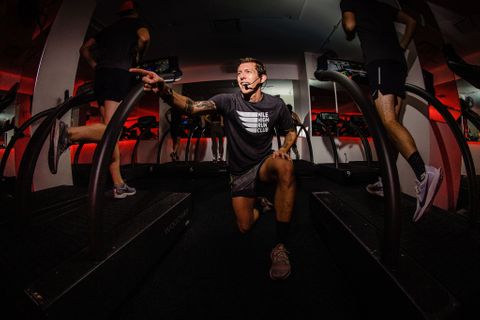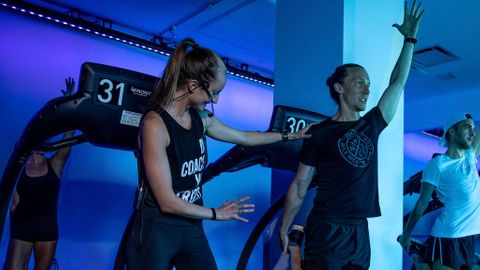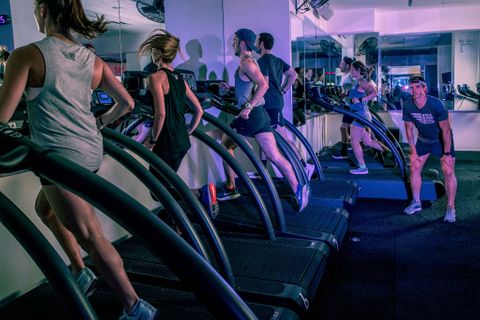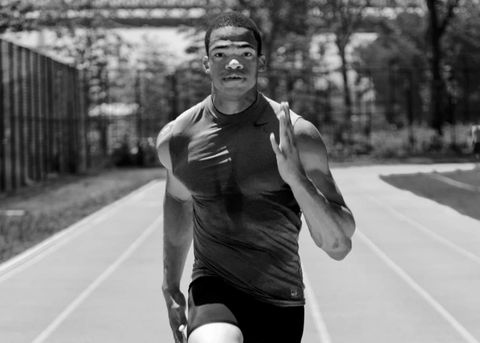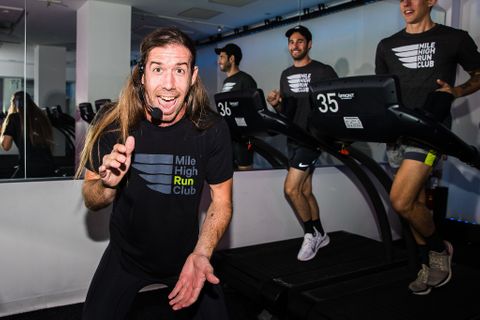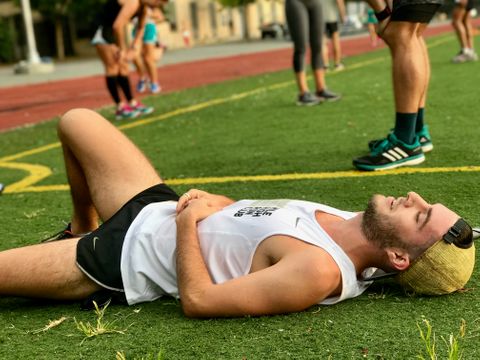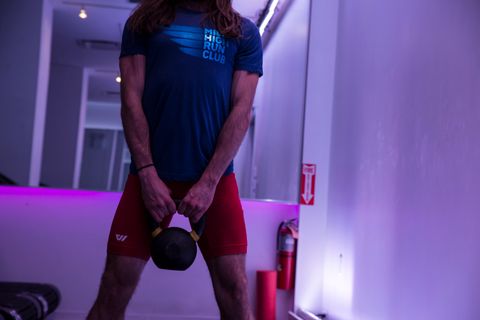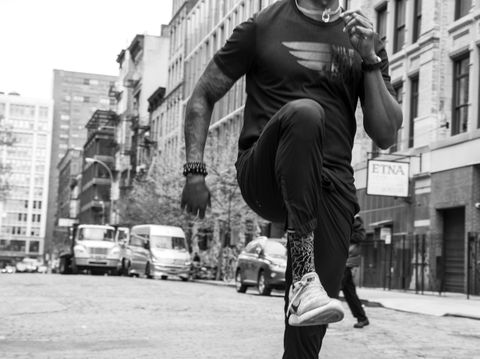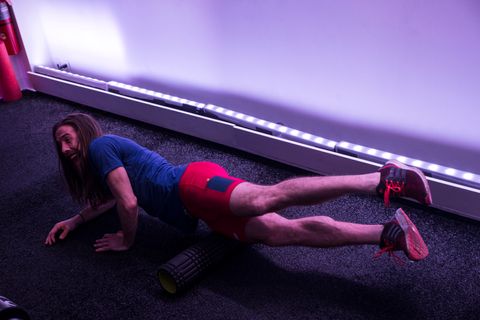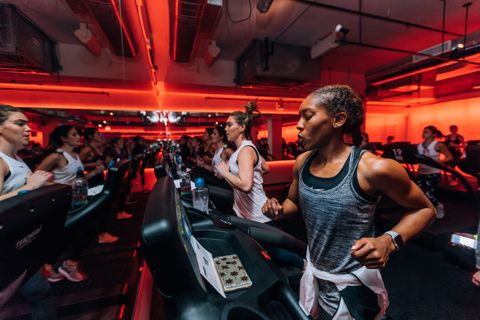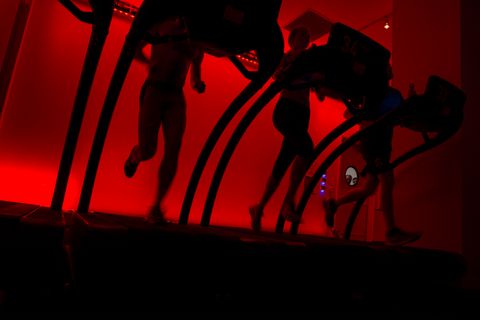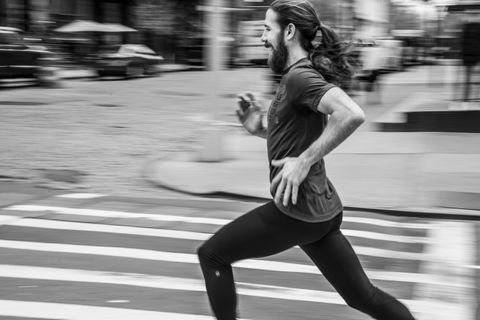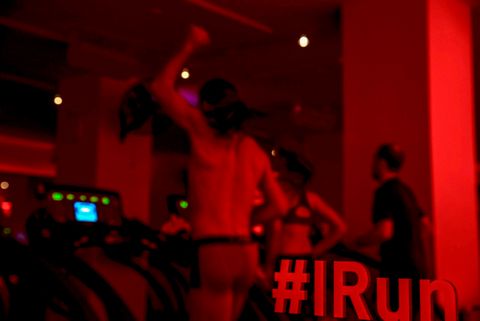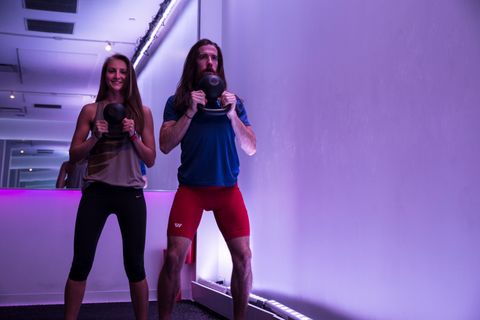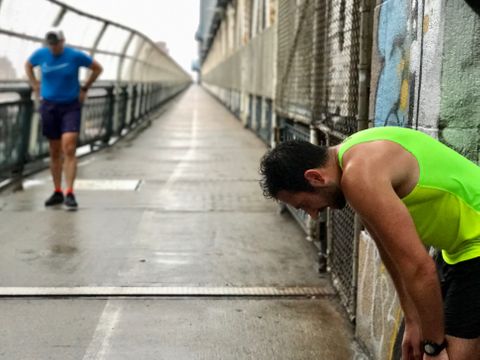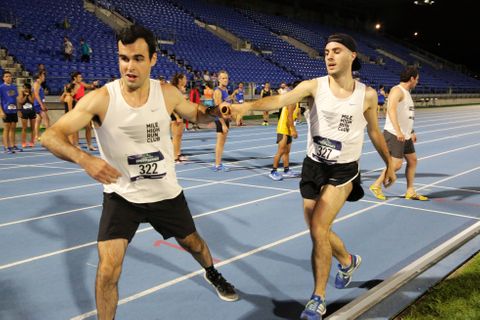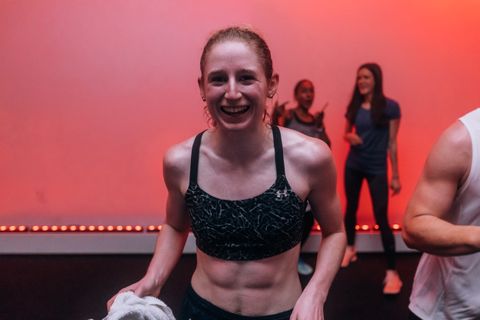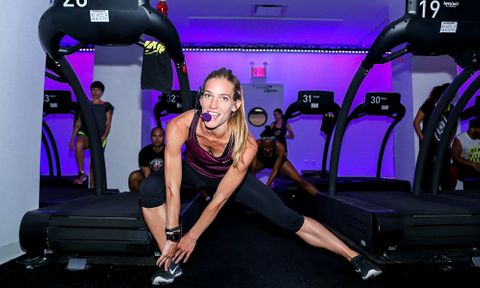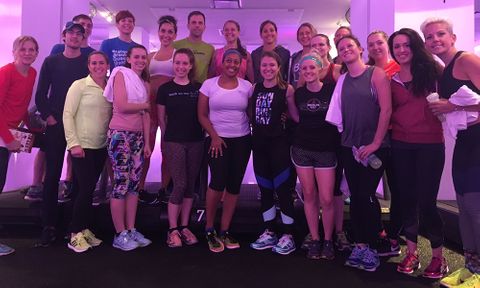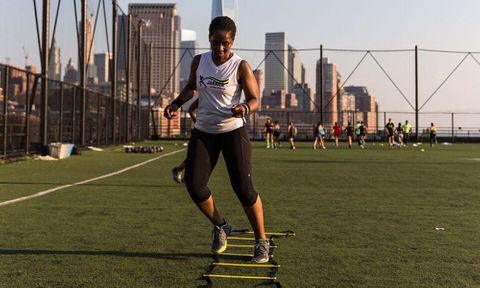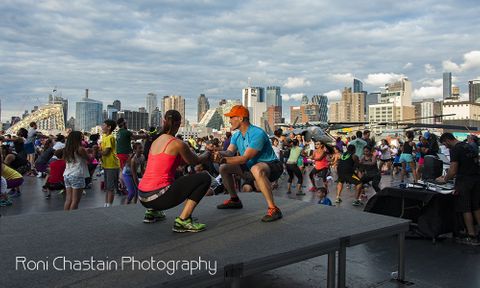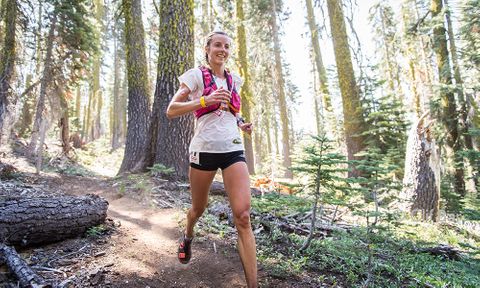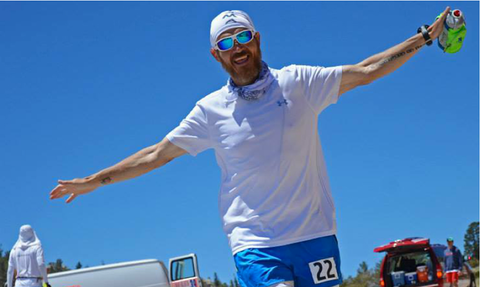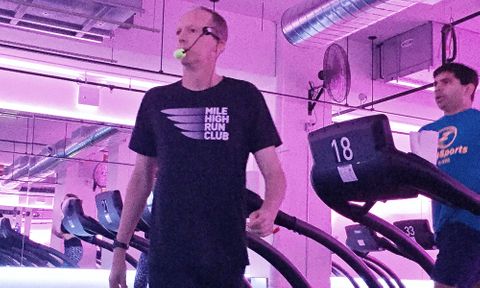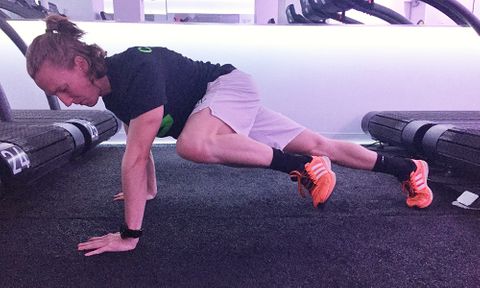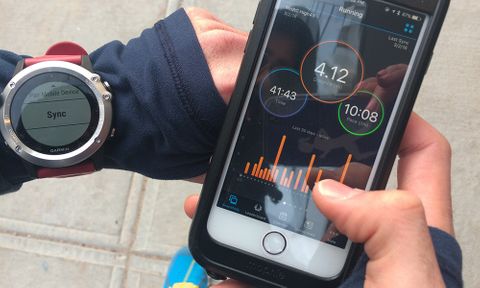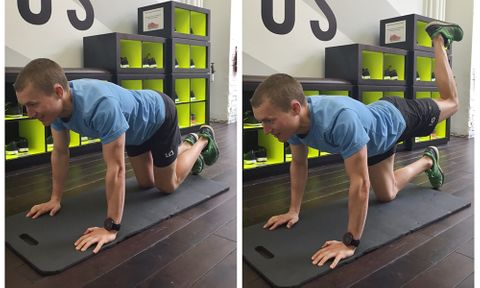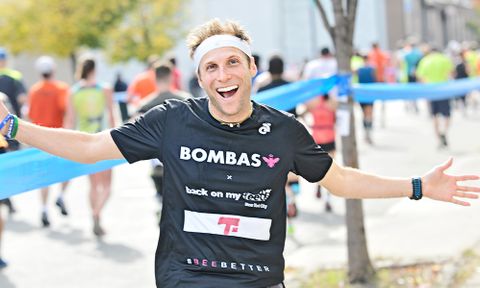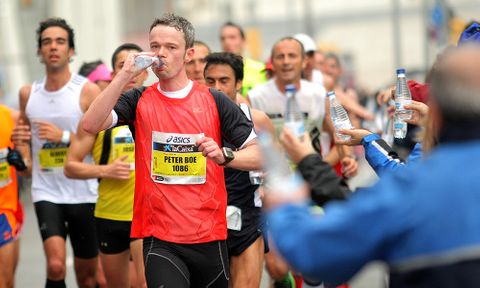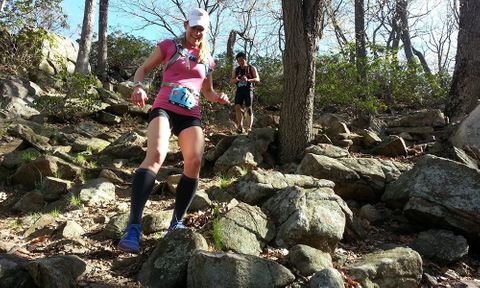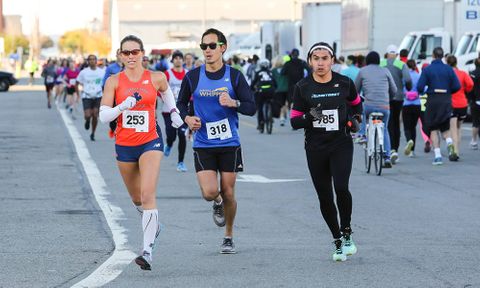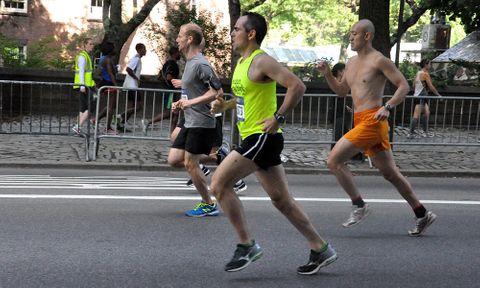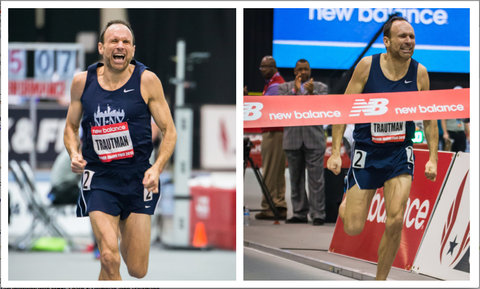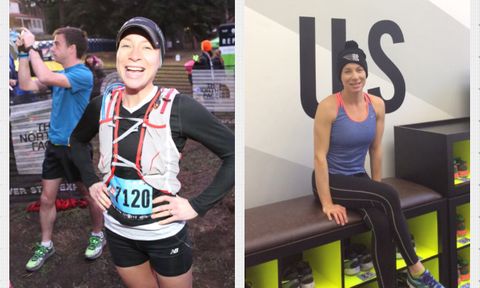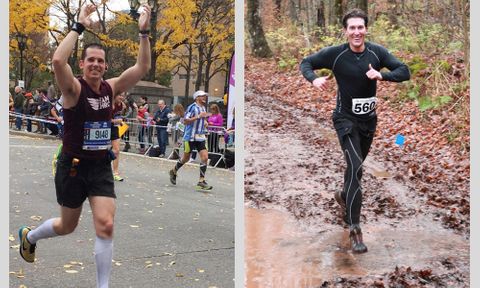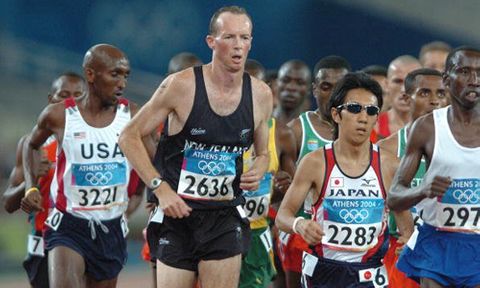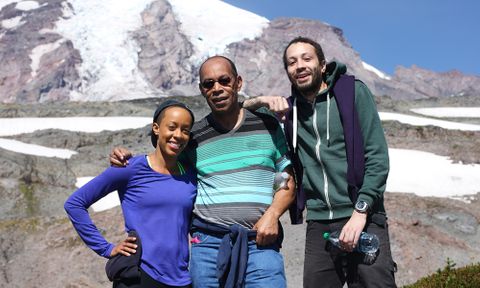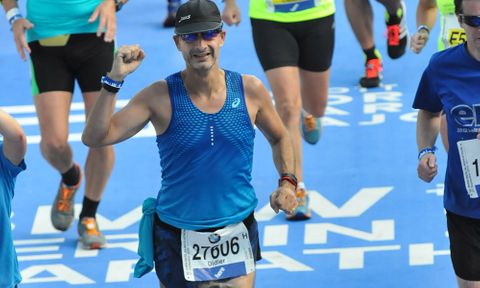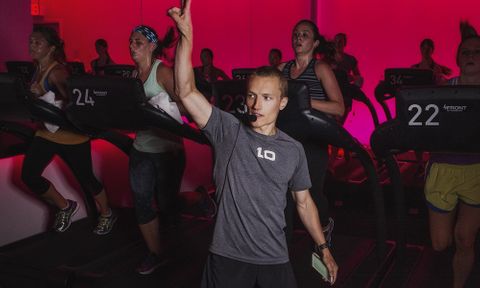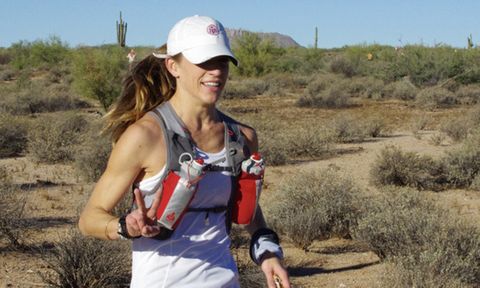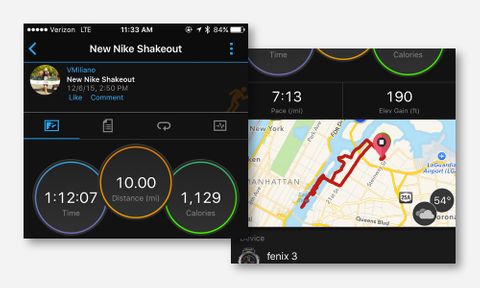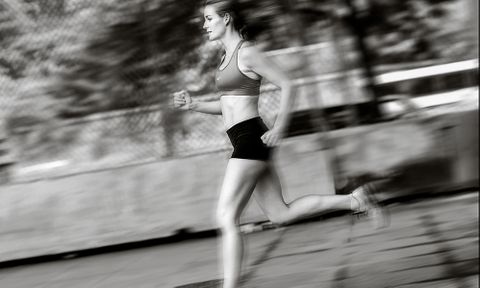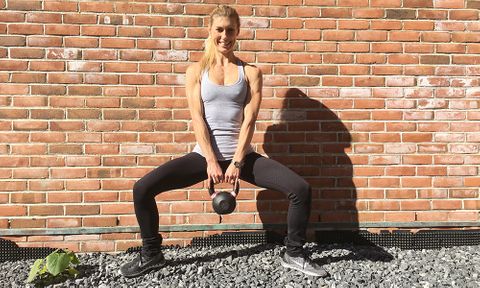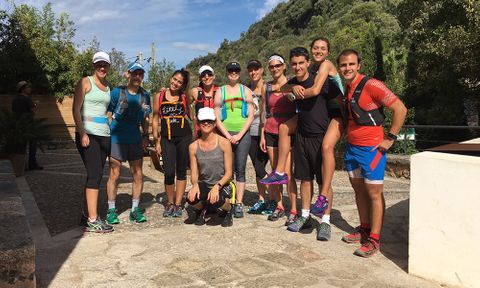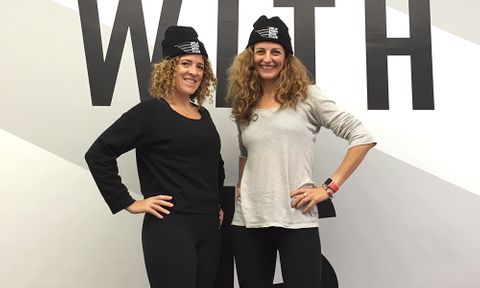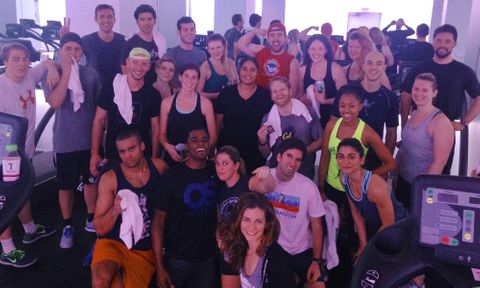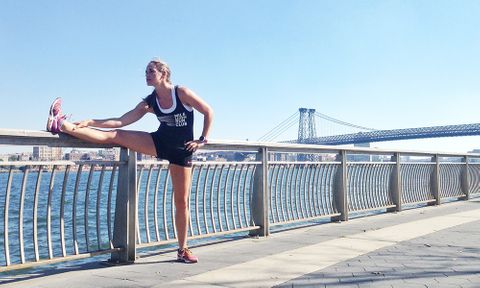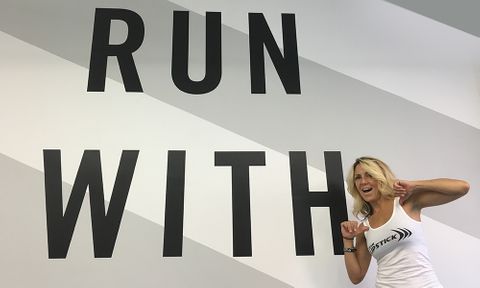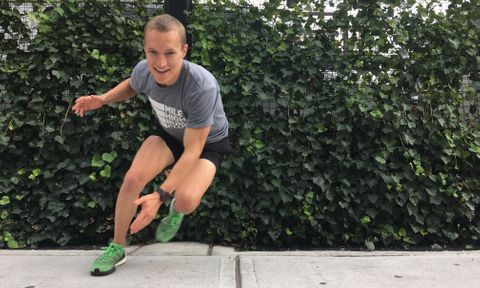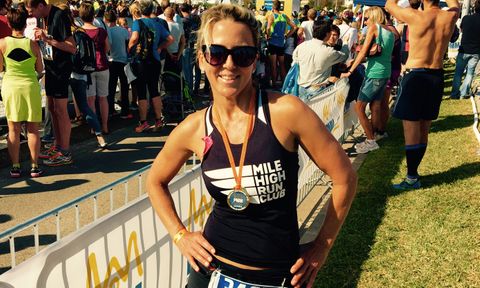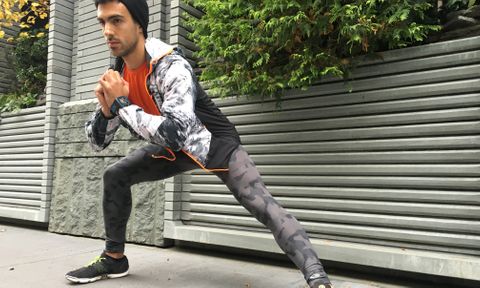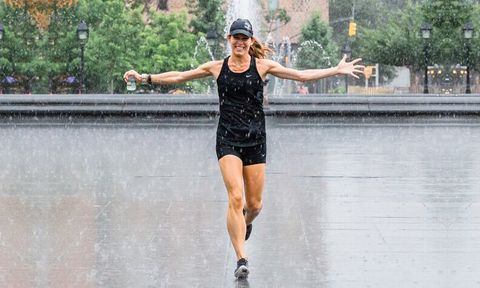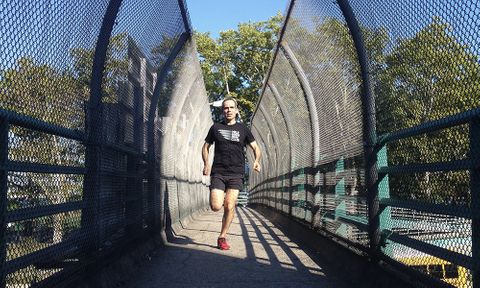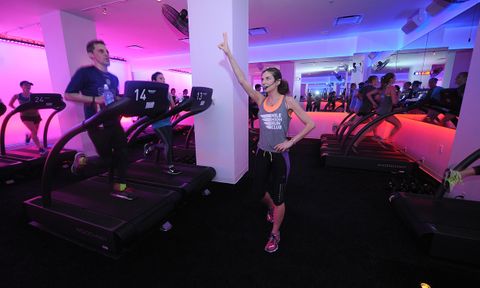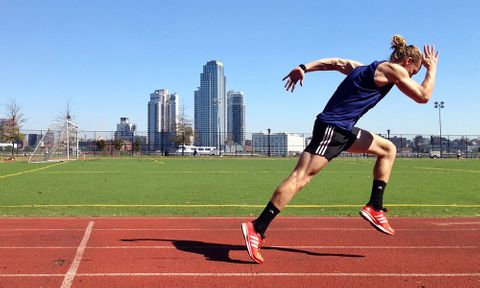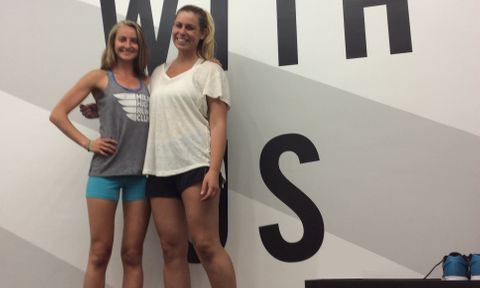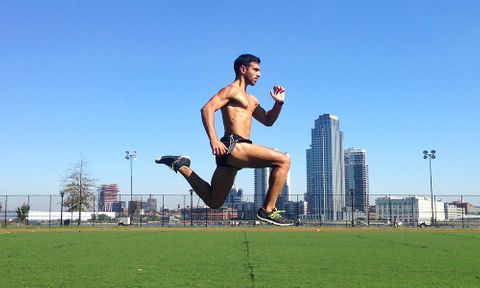The Mile Marker
Marathon Season is Here: Top 5 Things You Need to Know
Coach Raj
The days are becoming shorter, the temps are beginning to drop, and the leaves are starting to turn. These signs of fall compel many people to order pumpkin spice lattes and go apple-picking in the suburbs. But for us at Mile High Run Club, this means marathon season is here!
Coming up, we have Berlin, London, Chicago, Boston, LA and of course, New York City on November 7.
Whether you are training for a fall marathon this year or in the future (there is no other option), we have five top tips to help you run smarter and achieve your goals.
1. Know the course: Adapt your training based on the race course. If there are hills, eat hills for breakfast. If there are turns, run the tangents better than Pythagoras. And if you’re local to the race, train on the course to be mentally and physically ready and make molehills out of mountains!
2. Remember your nutrition: Have a nutrition plan for the race and stick to it. Practice it during training, using fluids, electrolytes, energy gels, and even caffeine for an extra boost. Know...
moreWinter Running Tips
Leslie Dugger
Running in the winter isn’t always fun but it doesn’t have to be terrible.
You don’t have the advantage of just being able to throw on some shorts and go. You should take a couple extra minutes to prepare for the weather outside so that you can actually enjoy your run (and not just suffer through it)!
Do a 10-minute dynamic warm-up inside. Lunge matrix, leg swings, arm swings, fire hydrants, jumping jacks. This gets your body warm to reduce the risk of injury. It also gets you feeling a little steamy so that you aren't so miserable when you step out the door.
Keep your head and hands warm. Wear gloves or mittens. Put on a hat, ear warmers, or headband. These can all be taken off pretty easily and carried or put in a pocket if you warm up too much. I also almost always wear gloves under 55°F because my hands get cold easily.
Wear layers BUT underdress by a few degrees. If you go outside and you’re comfortable, you will probably get too warm on your run. It’s okay to be chilly when you first step outside...
moreFinal WORDS GOING INTO NYCM race week
Melissa Wolfe
The proverbial “hay” is in the barn. In these last few days leading up to the big dance, trust your training, regardless of whether it went according to plan, or you wish it had gone otherwise. You put in the work and you can only be where you’re at on race day. Trust and be proud of what you’ve done...it’s time to cash out on what you’ve put in! Now let’s talk about some ways to make the most of it:
ONE: Stay warm at the start. Right now, Sunday’s weather is looking absolutely perfect for a marathon, which means it’ll be great temperatures to run in, but it’ll be a bit chilly in the Start Villages. Layer up and keep important muscle groups nice and toasty; glutes, hamstrings, and core. A hack I’ve used in the past is using peel-and-stick foot warmers. I stick them inside my sweatpant and sweater layers so that while I’ll sitting down and waiting to line up in my corral, I’m not spending energy allowing those muscles to tighten and tense me up with shivers! Get some movement in and keep the blood flowing. It’s a common misconception...
moreThe Running Brain
Kellen Bulger
Mental health conversations are becoming more and more mainstream, so should conversations about falling in and out of love with running.
When esteemed American 800 meter runner Brenda Martinez tested positive for a banned substance in the fall of 2020, those of us track and field fanatics were shocked. Doping is a cardinal sin in endurance sports. In Brenda’s case however, what came to light was that she was not a product of a meticulous cheating effort. Brenda’s positive test was because her antidepressant was contaminated with a diuretic by the name of hydrochlorothiazide. After competing in both college cross-country and track, as well as becoming a running coach here in New York, it’s clear that Brenda Martinez is not the only runner to excel in competition, while also facing intense demons off the track.
Distance running is a sport that demands minimal days off and constant physical exhaustion. For folks whose mental state drastically swings from stable to insecure at best, running can quickly become a fickle...
moreHow to Stay Motivated and Keep Moving {Together}
Coach Raj @runwithraj
Although the pandemic has put a hold on our indoor treadmill classes, you can still find ways to stay motivated and keep moving with the launch of our new Mile High Audio App! Whether you tune in outdoors or indoors, try workouts that will improve your endurance with tempo efforts, test your speed with short intervals, or zone out during long runs.
Like many of you, I miss my routine. Every Tuesday morning, I would run in Coach Vinnie’s 5:30AM treadmill class and then coach the 6:30 and 7:30 classes. I engage with runners before and after classes, hearing about what they’re training for and sharing advice from my experience.
But as much as we love routine, runners know how to embrace discomfort and uncertainty. In fact, we do this every time we show up to the studio, willing to tackle a new workout and push our mental and physical limits.
As individual as running is, there’s no denying the benefits of taking on this challenge with our community. The Mile High Run Club is run better,...
moreLive Streaming
Mile High Run Club
Runners (and New Yorkers) persevere. Plain and simple. Our sport, our passion, our shared love for this city and our drive to be better {together} will endure - even while we are apart. That's why amid this crisis, we are excited to launch a schedule of in-home workouts LIVE brought to you by our coaches!
Welcome to a new kind of Club.
This is how it works:
- workout schedule updated daily
- in-home workouts with little to no equipment needed
- these workouts include strength, recovery, yoga, and more
- workouts will be streamed LIVE on Instagram
- although free, a donation page is open to help all of our coaches through this difficult time!
Right now, we need to remember that we are part of an amazing community. Social distancing doesn't mean social disconnect. Your team, your coaches, your friends are still here - and we want to connect...
moreUntil Further Notice, NYC Studio Closure
Mile High Run Club
In light of what has transpired with the Coronavirus (COVID-19) in the last 24 hours and also as an act of solidarity with our greater NYC community, we will close all studios as of today, March 15th. We will closely monitor the situation and expect to be closed until at least March 31st.
This decision is being made first and foremost with your and our employees collective health and safety in mind. This vicious virus is not going to contain itself unless we do our part to help prevent its spread. The need to close is further necessitated with the news of NY state schools closing, as we have many employees who will need to be home to care for their children.
It is with heavy hearts that it has come to this, as the ethos of our brand is run better {together} and it is this community of incredible runners, athletes, and individuals that drives us every day.
As we prepare to close our doors, we have a couple things to update you on first.
Memberships and Packages
For those of you who have memberships or packages,...
moreUpdate on COVID-19: March 14
Mile High Run Club
We have some important updates to share with you. Here’s what you need to know:
- Modified Schedule: Starting today, March 14, we are modifying our class schedule across all studios. This schedule is still subject to change as new events/information come to light. Check the Modified Schedule.
- Class Cancellation Policy: To help everyone make smart decisions without fear of losing credits or incurring cancellation fees, we are suspending all late cancellation fees and all loss of credit penalties. But please let us know as soon as possible if you are unable to make class.
- Memberships + Packages: If you are socially distancing yourself and would...
Update on COVID-19
Mile High Run Club
NEW UPDATES AS OF 3/14
Starting March 14, we are modifying our class schedule across all studios. This schedule is still subject to change as new events / information come to light. Check the Modified Schedule.
To help everyone make smart decisions without fear of losing credits or incurring cancellation fees, we are suspending all late cancellation fees and all loss of credit penalties. But please 🙏 let us know as soon as possible if you are unable to make class.
As you can imagine, we are receiving a great deal of emails from our runners. We ask you to please be patient as we work through them and try to respond to all of you in a timely manner. We are trying our best as we tread new ground and the situation continues to change.
If you are socially distancing yourself and would like to freeze your membership or extend the expiration date of one of your packages, we totally understand. Please reach out to...
Mile High’s Mile Whys:
Coach Mary Cain (@runmarycain)
I may be biased, seeing as I train and compete in middle- distance events, but I believe the 1500/mile is one of the greatest events in track and field. To start, the event has an amazing history due to the early debate of whether or not a person could break 4:00 in the mile. Although we have long since proven men are capable of crushing this barrier, the intrigue remains and every year hundreds of people attempt that feat. More interesting, though, is the women’s 4:00 equivalent barrier - or trying to run in the 3:5X in the 1500m events. Fewer women have broken 4:00 in the 1500 than men in the mile, so every time someone dips under the barrier, it’s a history-making moment. There are countless other barriers, though, that make the race exciting. Whether it’s breaking your own personal record or dipping under 5:00 or 6:00 for the first time, the races are always fast and thrilling to watch.
The mile, however, is not just interesting due to the barriers daring to be broken. The mile is exciting due to the unique nature of fitness the event requires: it’s the perfect mesh of...
moreMy Miles, My Journey: The 5000m
Coach Conor
Racing on the track is such a unique experience. To me, the track is where all things are equal. No hills, no bumpy roadways or potholes. The races are smaller, maybe 15 to 20 runners, instead of 5,000 to 20,000.
The track is where excuses take a back seat to PRs.
It's been proven that the best way to PR is to run even splits from start to finish. Easier said than done. The track affords you the opportunity for constant information. Splits every lap, even every 100 meters if you want. You always know where you're at. You can see everyone in the race all at the same time. It's tactical. The decision to pass someone or fight off someone from passing you is ever-present.
My best 5000M race ever was on the track. The goal was simple (and challenging): run under 15 minutes. My PR going into it was 15:18, and my training had been going well, so I was confident I was ready for a breakthrough. Now 12 1/2 laps around an oval may sound boring, but with the goal of consistent, even splits, boring isn't a bad thing. 15:00 for 5k = 4:48 per mile = 72 seconds...
moreRunning is Better {Together}
Written By: Kevin Weatherman Contributing Editor: Kayla Weatherman
Our Story
On November 23, 2019, we accomplished something that neither of us dreamed possible just a few short years ago. We completed the Philadelphia Half Marathon. We didn’t just complete the race, we crossed the finish line hand-in-hand.
Before I found Mile High Run Club— on my way to losing 65 pounds —I dreaded running. And before finding MHRC, my wife (Kayla) was an experienced runner who’d lost touch with the joy of it. And yet, that day, I was able to complete my first-ever half marathon, while Kayla was able to break a five-year hiatus and set a new PR.
We attribute our success to supporting and pushing one another and having several great places to train, including at MHRC where we found a community of incredible and encouraging coaches.
The Journey
I never thought l’d be able to run a half marathon, let alone enjoy running it. In 2016, I got a wake-up call when I was rejected for life insurance. At 240-pounds, I’d been classified as clinically obese. I knew then that he had to make...
moreOn the Brooklyn Half
Coach Tim (@tedowney)
The Brooklyn Half, the largest half located in NYC’s backyard, is one you don't want to miss. It’s known as a fast course, but the crowds from the beginning to the end are what make it so fast. You won’t go more than 1-2 miles without seeing familiar faces from clubs, friends, or family— all the way to the final stretch down the boardwalk!
That said, friendly faces can only take you so far and it is only fast if you’re ready for it— there are hills at the beginning and some subtle rollers throughout the straightaway heading to Coney Island.
The best way to prepare for the hills...TRAIN ON HILLS. Whether it’s incline on a treadmill, loops in the park (central or prospect), or running bridges. Nothing will get you more prepared for the varying paces you’ll need to run and prep the muscles your body will use going up and down a hill than actually doing it.
Perhaps one of the more challenging parts of the race will be the first 4 miles through the park— staying patient while you see others going out faster is key. Remember it’s a half marathon; after you exit the...
moreWhat to Eat After a Run
Sammi Haber Brondo, MS, RD (@veggiesandchocolate)
In my last post, I talked about what to eat before a morning run. So, now that you’re an expert on what to eat before your morning run, let’s talk about what to eat after.
When we run, our bodies use our glycogen – or carbohydrate – stores for energy. Even if you only went on a short run, it’s likely that you used up a lot of your glycogen stores and need to replenish them.
On top of that, our bodies require protein for muscle building. Protein helps to rebuild any muscle that’s broken down during exercise and helps to continue to build new muscle – both of which are super important for runners.
So, after a run, aim to eat something that contains both carbs and protein. This combination not only replenishes glycogen stores and helps to rebuild muscle, but also helps you to recover faster.
Additionally, when should you aim to eat after your run? While I know it’s not always realistic to eat right after your run (you do have to shower!), try to eat within 45 minutes after you’ve finished. This window helps give your body those nutrients it needs at the most...
moreWhat to Eat Before Your Morning Run
Sammi Haber Brondo, MS, RD (@veggiesandchocolate)
Mornings are rushed. I get it. The last thing you probably have time to do in the morning is cook a gourmet breakfast. On top of that, when you’re headed out the door to run, your stomach also likely can’t even handle a full gourmet breakfast. So, what do you eat?
As a registered dietitian, I tell my clients to focus on 2 things when it comes to those early pre-run breakfasts: something easy, and something that contains carbohydrates.
Carbs are our bodies’ preferred source of energy, especially in exercise. When we run – whether it’s 3 miles or 13 – our bodies rely on our carb stores, called glycogen, for energy. This is why you hear about people “carb loading” before big races. Carbs are what give us the energy we need for exercise.
But, not all carbs are created equally. Right before a run, a food with too much fiber or a food that takes too long digest might seriously upset your stomach. Think about eating an apple: it takes a while to chew and a while to fully digest. Definitely not the best choice for those pre-run mornings.
Instead, focus on easily...
moreThe Hay Is In The Barn
Coach Matt Meyer
Congratulations runners! You've made it through another sweltering summer of training for a fall race and now you've arrived at the last challenge - the taper. Yes, you put in all the good work but these last few weeks are critical to showing up on race day at your best.
So here are some key Do's and Don'ts for your taper.
DO Prioritize your sleep and health. It doesn't matter if you spend all day alternating back and forth between compression boots and a cryo chamber, getting at least 8 hours of sleep (if not more) is the foundation of your recovery plan.
DON'T Try to cram in any last minute workouts. You're not going to get any fitter in these last few weeks but you can definitely lose it on an overtraining injury. There's no "magic final track work" that's going to make or break your race.
DO Mentally plan your race. When I'm on my easy runs, I love mentally navigating how I want to run on race day. My plan for pacing, when I'm fueling, how I want to tackle the...
moreAMA with Coach Jess at the Berlin Marathon
Coach Jess
On Sunday, September 29, Coach Jess ran alongside 46,982 other athletes at the 2019 Berlin Marathon. Beforehand, she hosted an Ask Me Anything: Marathon Edition on our Instagram. With the Chicago and NYC Marathons quickly approaching, her tips for training, tapering, fueling, and resting are as relevant as ever. Enjoy the Q&A with Coach Jess as she dives into the last 24 hours before her race!
Q: How do you relax before race day?
A: I do an easy shakeout in the morning. Then I make sure I have everything I need and have my logistics sorted early so I don't have to figure anything out too late in the day or the morning before. Then I sped the rest of the day relaxing! It's easier for me to relax here in a hotel and I have less "to do" than being home in NYC so I am taking advantage of hotel life right now. An early dinner up next, then bed. Hope to be able to sleep but I have a lot of pre-race excitement and am bad at resting.
Q: Tips for tapering before the race?
A: 2 weeks out: last...
moreA Case For The Treadmill
Coach Rich Binning
Long before I became a runner, let alone run coach, I was a Run Hater. The only thing I found more pointless than running was running in place on a treadmill, going nowhere, like a masochistic hamster on a wheel.
Let’s just say I’ve come a long way.
I came to running later than most of my run coach contemporaries. Mile High Run Club boasts a coaching staff of those who were high school and college stars as well as professional athletes. Most of them had a complete and accomplished career before I had ever run farther than a mile — and I only did that because the gym teacher made me. Doing a complete 180 on the whole running thing was like going on a first date with your high school nemesis, but it turns out they’re really sweet and asks you lots of questions about yourself. Not a perfect analogy but you get it.
Listen, running is hard, I get why people think they don’t like running. But I’ll never forget the first run I did where I experienced that thing I’d once heard about but didn’t know actually existed: the Runner’s High. I was hooked. A full-on junkie. I...
moreUsing Form Cues to Block Out Negative Thoughts
Coach Mary Cain (@runmarycain)
We’ve all been there. You are midway through an interval, workout, or run and suddenly your thoughts start running wild. You begin to doubt your mind and body and if you don’t snap yourself out of these negative internal thoughts, it becomes hard to push yourself and in the worse-case-scenario, you drop out before the end of your intended session.
What I’ve found to be the most interesting part of becoming a coach at Mile High Run Club is that I have had to learn cues to snap my runners out of these mental downward spirals. Of course, a simple positive cheer can help many people blow through those proverbial “yellow lights” to regain an uninterrupted mental focus, but sometimes it takes more than that.
As a coach, I’ve learned that physical cues are the most helpful in relaxing our minds and bodies, and therefore getting us to push through rough points. By giving your mind a chance to focus on and take control of something else, we leave behind the more abstract concepts of how you feel in a given moment and instead focus on a very physical feeling. For example, as...
moreWarming Up for the Warm Up
Coach Mary Cain (@runmarycain)
As a coach at Mile High Run Club, I’ve started to hear one question come up a lot: “Do I need to warm up for my warm up?” In those minutes before class starts or as people congregate outside to begin a run, I notice runners looking around nervously. They watch their friends and fellow-runners stretching, hopping, or jogging before the day’s work has even begun, so they start to wonder what’s the best way to prepare for the day’s session.
To start, everyone’s pre-run routine is different. Through some trial and error, though, you can begin to create a system that works best for you. Here are some tips and tricks to help your body feel ready to go before the run has even begun.
Mobility:
First things first, I like to start all training with joint activation. Running is high-impact, so doing some dynamic movement pre-run helps to loosen up your joints and prepare your body for some pounding. This mobility segment can include ankle, knee, and hip circles to loosen your joints.
Stretching:
After mobility, do a quick body...
moreThe Marathon: How Training Slower Can Help You Race Faster
Coach Marni (@mmmarni)
Running a marathon is exciting. There’s a certain thrill that comes with setting a big goal or pushing further than you’ve ever gone before. Maybe you get to travel to a different state or country. Maybe you’re staying local but experiencing the city in a totally new way. The potential in 26.2 miles is so much more than just the distance—and the carb-loading is equally limitless (in my opinion, the best part).
Training for a marathon is… less exciting. If you’ve done it, you know: the early mornings, earlier nights, long miles, insatiable hunger and overall fatigue that sets in with too many weeks left to go. The human body is incredible, but it’s not invincible. As I lined up for the Reykjavik Marathon not too long ago, I wondered for the hundredth time whether my training was enough. If all of those slow, easy miles would somehow translate to a fast race. It seemed like a stretch, but at that point, there wasn’t anything I could do. The gun went off and so did I.
Spoiler alert: I hit my goal time. Didn’t hit “the wall.” Qualified for Boston. Ran a negative split...
moreThe Rundown on Running Terminology
Coaches Yusuf, Tim, and Matt
Fart-wha?
Ever heard our coaches use the term Fartlek and have no idea what it means? Or inwardly groaned when a Coach tells you that the workout for today's class is going to be repeats? In this week’s blog, Coaches Matt, Tim and Yusuf breakdown the different running terminology you might hear, explain how and why the specific workouts we do in class help improve your running and even provide workouts for you to try on your own!
FARTLEK: Coach Matt (@matthewlukemeyer)
Fartleks! No only fun to say, but a fun way to get some fitness. A Swedish word for speed play, it really focuses on keeping PLAY part of the workout by going back and forth between harder efforts and easy jogging recovery. It can be structured (ex: 3:00 hard effort / 3:00 easy effort) or unstructured (ex: run hard in between every other stoplight). So if you feel like you've been tied down recently by intervals on the track, this is a great choice.
Fartleks are a key part of any...
moreThe Need For Speed
Coach Alain (@myfitnessal)
It’s speed day!!! What now? We like to go fast, but how fast?
If I’m not first, am I really last? (Thanks Ricky Bobby). Speed work, at its core, is all about running faster, for a much shorter distance, usually in an interval format. You focus on great running form, and tap into those energy systems that you might not use in your other training runs. It burns, it hurts, and you come face to face with yourself several times over. It’s essential because training for a higher speed threshold can contribute to faster, more effective training runs, which in turn contribute to...yup, PR’s!!!
Soooo speedwork is (run it by me again)....?
Simply put, its running lower volume intervals, at a higher intensity usually at or right below your VO2max. Instead of sending you down a google search black hole of calculations for your VO2max, just think of it as close to parallel to your heart rate. That number that we’re looking for is around 90% of your max heart rate. As a ripe old 32 year old, my max heart rate sits at 188 bpm ( 220-age). 90%...
moreThe Mile High High
Coach Ryan McCann (@coachmactruck)
Greetings, one and all! Coach Ryan here.
On behalf of Mile High Run Club, and our kickass community of runners and athletes, it is my honor and pleasure to be writing the inaugural Coaches Newsletter. It will cover everything under the sun, from running and fitness tips, news and updates on local events, insights on training and nutrition, and whatever else we believe will help you SMASH your goals and be your fullest self.
We are a community built around the idea that health is wealth, and we want to make you filthy rich! So join us as we explore the wide world of fitness and wellness, and let us be your sherpa!
First things first. The most important question to ponder — Why?
Why do you practice? Why do you run? Why do you eat healthily? Why not?!
It’s important because most of us want a deep sense of purpose and passion in our daily lives. We want to feel like our words and actions are intentional, thoughtful, and packed with meaning. Of course, sometimes all we feel is stress and anxiety, as though it’s a constant grind to keep our ship on...
moreSunday Tips from MHRC: How breathing right can change your run!
Something so simple, yet often overlooked...
Take a big, conscious inhale in. And release.
It's not often we think about our breath but it's one of the simplest ways to improve our run! With a few quick exercises, you can gain confidence, improve efficiency, promote balance and strength, and reduce fatigue.
Finding balance with your breath is as easy as staying aware of it; change your focus from to-do lists, music lyrics, random thoughts, or work emails to your body's natural rhythm of inhale-exhale.
As you run, matching your breath to your footstrike helps the brain and body work together to find balance.
Try a rhythm of three steps in, two steps out at slower speeds, and two in, two out for faster speeds.
Letting the mind wander is OK, but always coming back to the breath will help the mind and body connect.
Not running right away? Try it as you walk around your office or around the city!
moreFinding the optimal footstrike to amp up efficiency
Build from the ground up!
As we progress as runners, we start to look at ways to improve efficiency. Whether we're just starting out or are seasoned marathoners, it's always helpful to check in on our footstrike.
Finding the right footstrike (where your foot makes contact with the surface) is key to optimal performance. Ideally, we want to land close to our center of gravity.
How is it more efficient? This simple form correction leads to minimal contact time with the ground and keeps us from wasting energy.
PUT IT IN PRACTICE!
Start off slow in a controlled environment (like Mile High!) with your core engaged and hips forward.
Be conscious of where your center is - generally the area around your belly button.
As you start to move forward, think about minimizing contact.
Be mindful of over-striding and avoid dragging the legs back once they make contact.
Try it on the tread & take it to the street!
moreSunday Tips from MHRC: Using the right weight for Dash28 to get the best bang for your buck!
We LOVE the versatility of the kettle bell for strength and power in our Dash28! It's not always easy to know which weight to grab after a hard run, but we're going to give you the run-down on what weight is what!
- MHRC Noho | MHRC NoMad
- 9lb - White | Yellow
- 13lb - Grey | Blue
- 18lb - Pink | Pink
- 26lb - Blue | Dark Blue
- 35lb - Yellow | Orange
Use this handy guide to be able to grab the right weight for your next class!
Don't be afraid to train with heavier kettlebells in order to increase your overall strength and lean muscle mass. One should be able to maintain core stability and control while using the weights. We generally recommend lighter weights for overhead & upper body movements and heavier weights for squats & lunges.
All Mile High Run Club locations proudly use KettleBell King brand kettle bells.
moreSunday Tips from MHRC: Get the most from your run by cross training right!
We're all about being the best runner you can be. Cross training is considered to be one of the best ways (when done right) to make you a stronger runner.
Cross-training is often misunderstood. Mixing it up is NOT cross-training. Strength training is NOT cross-training. Spinning is NOT cross training. And, sorry yogis, yoga is NOT cross-training either.
You should still do these activities for your health and fitness, but let's not call it "cross-training" because technically, it's not.
In order to cross-train properly as runners, we benefit the most from cardio-focused modalities that stress the cardio-respiratory system in a similar fashion to running. The best activities to support your run are listed below.
- Stair climbing
- Elliptical
- Cross-country skiing
- Hiking
- Deep water running
Lucky you! You can work on your running game even when you're not running if you follow these tips!
moreSunday Tips from MHRC: Fire it up with dynamic warmups!
Before you run, take a time to activate and lubricate!
If you've taken our Dash 28 or run our #NightAtTheTrack, you know we don't mess around with warmups. Dynamic warmups activate the specific muscles you'll be using during your run as well as help lubricate joints and improve in-run mobility.
Follow these simple guidelines when warming up before your next run:
IT'S ABOUT FORM- concentrate on the mind/muscle connection
SLOW AND CONTROLLED- don't sacrifice proper form for rushing the warmup
FULL RANGE OF MOTION- this is your opportunity to find the big movements to really open up the body to the stress of running
BECOMING CONSCIOUS OF OUR BREATH AND BODY- part of being a good runner is listening to our body. Finding your breath and your connection to the activity will help you on your journey
moreSunday Tips from MHRC: Roll it Out!
Don't fear the foam roller- just take it an inch at a time.
We all know the benefits, but foam rolling can be a scary thing if you don't know how to use it!
With some quick tips, you'll be able to make the most of this amazing tool.
You're in control of the pressure- body weight and support will increase or decrease the pressure applied on the targeted muscle
Take it an inch at a time- finding the "sweet spot" as you roll a specific muscle means taking it slow and concentrating on rolling back and forth about an inch at a time
It's not JUST for rehab- use a foam roller as pre-hab and as a way to keep your healthy muscles staying stronger for longer
Try these runner-specific targets: calves, ITB, piriformis, hamstrings, glutes, adductors, and quadriceps
Mile High Run Club uses TriggerPoint foam rollers available in studio pre- and post-run
Have ideas for future tips? Email us!
moreSunday Tips from MHRC: Dress Properly
This week, we bring you a few more reminders for running in heat & humidity!
DRESS PROPERLY! Wearing a hat will keep the sun and sweat off your face & out of your eyes.
PLAN! Try to avoid peak sun times, mainly 11am - 2pm.
BALANCE! If running long runs, supplement half the run with a Mile High class. This will only help in your overall performance as your body adjusts to the longer distances with the combination of speedwork.
Did you know?
Taking a cold shower will not shield you from that post run sweat. Allow yourself an additional 30 minutes post run for your body temperature to lower, if possible.
We are runners, we geek out on this stuff, and know you do, too. Have ideas for future topics? Let us know!
moreSunday Tips from MHRC: Slow Down!
This week, we bring you a few reminders for running in heat & humidity!
SLOW DOWN! When running for an extended period of time in extremely warm temperatures, your focus should be on remaining comfortable throughout the run and not the overall pace.
STAY HYDRATED! Take in sips of water every 30 - 40 min of running
REFUEL! While water is always a good idea, remember to refuel electrolytes. It's a simple as adding salt to your water and / or can be as official as gels or shot blocks.
Did you know?
You should expect your times to be five to eight percent longer than usual for the same distance. For example, say your forecast is showing a high of 77 degrees Fahrenheit with 85 percent humidity. That’s a dew point of 72 degrees. That means a run that takes 30 minutes on a good day will take around 32 minutes today.
We are runners, we geek out on this stuff, and know you do, too. Have ideas for future topics?...
moreHill Workouts: Intense & Short or Slower & Long?
Hill training is commonly used by distance runners to increase running speed. It’s been associated with increases in VO2max, lactate threshold, and running economy. But how can we get the most out of our hill training? (Because let’s be real, we all know it can be our most dreaded training day of the week.)
Should we be focusing on running uphill as fast as we can and taking breaks, or should we use a more comfortable pace to run longer with fewer breaks? A study published in the International Journal of Sports Medicine explores differences in hill training techniques and makes a few suggestions for how to get the most out of all our hard work.
The researchers used these performance markers to figure out how effective their interval training program was:
1. Maximum Oxygen Consumption (VO2Max): the maximum amount of oxygen that an athlete can utilize during maximal exertion – aka how efficient your cardiovascular system is
2. Velocity at Lactate Threshold: the velocity at which lactate begins to gather in the blood more...
moreHeart Rate Variability Training: What’s the Deal?
Like most athletes, runners are constantly looking for ways to make their training more effective. We have been hearing about "heart rate variability", or “HRV," more and more often in recent years. Many professional and elite level athletes have turned to HRV to help identify how intense their workouts should be and what their recovery should look like, therefore avoiding overtraining and undertraining.
So what exactly is heart rate variability? HRV is a measure that reflects change in the heart beat cycle over time, comparing one beat to another. It is sensitive to acute stress, which includes cardiovascular stress from exercise. An athlete who is wellrested will have greater time between heart beats, resulting in a higher HRV. An athlete that is stressed out, tired, and overworked will have less time between beats and will have a lower HRV.
This change in HRV reflects a nervous system imbalance, specifically of the autonomic nervous system. The autonomic nervous system is comprised of the sympathetic system and parasympathetic system. The sympathetic system is...
moreHamstring Tightness & Heel Pain
Plantar fasciitis is one of the most common injuries runners experience throughout their running lives. The most well-known symptom is heel pain when you get out of bed and take your first few steps in the morning. It occurs when there is repetitive microtrauma (ex: overtraining) to the plantar fascia—the connective tissue band that runs across the bottom of the foot. Research has found actual changes that occur in the plantar fascia tissue, and it has been shown that an alteration in the load-bearing characteristics of the foot may be an underlying cause of this condition. However, why and how these changes in load-bearing occur is unknown.
A study from the Foot & Ankle International Journal examined the relationship between plantar fasciitis and hamstring tightness. Fifteen people who had plantar fasciitis for at least 1 year were recruited into the study, as well as fifteen people to act as the control group. Hamstring tightness was measured for both groups—23 degrees for the plantar fasciitis group and 6.5 degrees for the control group (perfect hamstring...
moreWhen to use Music
A few weeks ago, I wrote about the influence of fast tempo music on running pace. The study I talked about found that the fast tempo music caused an increase in speed, but without an increase in perceived effort. The runners went faster but didn't feel like it was harder!
The next question is, is there a specific time during a run or race when music is most helpful? Is it better to come out of the gate, guns blazing by starting off with the fast tempo music? Or is the music more helpful towards the end, when a little extra motivation is always welcome?
A study out of the International Journal of Sports Medicine looked at this concept using a 5k race. Fifteen runners performed two 5k races without music, and their best time was used as a baseline. They then ran two more 5k races--one with music in the first 1.5k and one with music in the last 1.5k. The 5k with music at the beginning proved to be the fastest.
Interestingly (and consistent with the other study about music's effect on running pace), there was no increase in the runners' rate of perceived exertion...
moreThe Competitive Edge
Picture yourself on the starting line of a race or anxiously awaiting in your corral. Maybe you focus on your race strategy, your goal(s), or positive self-talk. You are aware of your fellow runners surrounding you, maybe jumping around or continuing to move to stay warmed up. This is a very different starting environment than say, your long run or a tempo workout. The question is: how does this affect you? What effect does being surrounded by other runners in a competitive environment have on your performance?
The journal of Physiology & Behavior recently published a study where researchers looked at the performance differences in runners when they ran a 3k independently (instructed to run it as fast as they could) and when they ran the same 3k with other runners.
The researchers studied 9 male distance runners (all recreationally trained). First, they took basic body measurements (height, weight, body fat percentage) and had them perform a maximal incremental treadmill test to determine their Vo2max, PTS (peak treadmill speed), and RCP (respiratory compensation...
moreCore Stability Risk Factor for Leg Injuries
Core stability. Planks. Ab work. Core strength. At this point in the game these are all terms we’ve heard about (or in my case, written about, talked about...) and learned to include in our training regimens. You know you’re “supposed” to do your core work, but are you doing it? Consistently? With purpose?
A study out of the University of Delaware examined specific measures of core stability as risk factors for lower extremity injury. They recruited 140 athletes over the course of 2 years—80 female and 60 male. The first year the researchers recruited basketball players, and the second the year they recruited cross country runners. Each athlete underwent core stability testing: hip abduction isometric strength, hip external rotation isometric strength, posterior core—back extensor muscle— endurance testing, lateral core muscle (specifically the quadratus lumborum) endurance testing, and anterior core endurance testing. The tests were performed by 4 different athletic trainers to insure reliability.
The head athletic trainers then kept track of any injuries (lower...
moreQuality Over Quantity
In the past few years, the benefits of HIIT programming have become more common knowledge in popular culture. We know that HIIT programming has been shown to improve performance in runners. An even more important take away is that these benefits can be achieved with adding HIIT and decreasing total mileage. Training methods are moving more towards focusing on mean running intensity, or the average effort/exertion over a training cycle, instead of weekly distance or duration.
A study published this month in the Journal of Strength and Conditioning Research took the steps to begin to determine how HITT programming improves performance. The study tested 13 experienced triathletes who were divided into experimental and control groups. Both groups before a sprint triathlon (in a controlled environment at the same sports facility) and were assess in squat jump and counter-jump movement height. Over 5 weeks the control group performed their usual swimming, biking, and running training regimens. The experimental group did the usual swimming and biking, but altered their running...
moreMusic’s Subconscious Influence
Anyone who has been to a class at Mile High can attest to the fun playlists that the coaches set up. Music is an enjoyable part of our workouts and can be motivating when we start to fatigue. In fact, I have met runners who will actually alter their training plans if they forgot their headphones!
A study examined the effects of fast tempo music on heart rate, running speed, and perceived exertion. It also looked at the effects of slow tempo music on post-exercise heart rate and lactate recovery rates.
Twelve people completed a self-paced 20 minute treadmill run and 20 minutes of recovery laying down in three different conditions: static noise, fast tempo music, and slow tempo music. Results showed that the fast tempo music condition had increased self-selected speed and a higher heart rate—without an increase in perceived exertion. Faster heart rate recovery was observed in the slow tempo music condition.
By listening to fast tempo music, the natural inclination is to run faster, and it doesn’t feel like extra effort. So take advantage of the class environment...
moreThe Short vs Long Warm Up
In our ever-busy society, so many runners often skip their warm up. They either run out the door first thing in the morning to be sure to get home in time to get ready for work, or they are rushing out of the office at the end of the day to squeeze in their run. (And then there’s the other group of us that just plain don’t do it.) The warm up is theorized to improve running performance because it increases your aerobic metabolism without causing an oxygen depth at the start of your run, allowing your anaerobic metabolism to be saved for the last part of performance. This has been examined in previous studies.
A new study compared the effects of a short vs long term warm up on a 3 minute running test. Thirteen endurance-trained athletes were tested, and it is important to note that they were from a wide variety of sports—not just runners. I would like to see a study more specific to runners, and distance runners even more specifically for that matter. That would give us some higher quality evidence for our sport.
The variables measured during and after the running test...
moreStrength Training for Runners? Won’t I Get too Bulky and then Become Super Slow and Then Fade into a Nice Running Memory?
I cannot express how often I hear this question when discussing strength training with distance runners, both male and female runners alike. I received my regular monthly email over the holidays from the Journal of Strength & Conditioning, and lo and behold—a study looking at the effects of strength training for distance runners in the long term! While it seems that “strengthening is good for runners” is moving more and more towards common knowledge, many are still concerned about the detrimental effects of possibly gaining muscle mass from such training.
The article that examined the effects of a 40-week strength training program on collegiate and national-level distance runners. Twenty runners completed the study, and all were tested before, at the midway point, and after the 40 weeks for the following measures: VO2 max, running economy, maximal strength (1 rep max back squat), reactive strength, and body composition. The runners were divided into two groups: the intervention group that performed both their normal endurance training and added the...
moreNo Pain, No Gain?
It is commonly said that sports toughen kids up, and we often see athletes in pop culture that have extremely high pain tolerances. It is widely accepted that athletes are tougher and can handle more pain.
Is there any evidence to back this up? And what about runners? Sure, we see football players in movies withstanding large amounts of pain, but we about the hardened distance runner?
A study from the American College of Sports Medicine looked at just that—does pain tolerance change with aerobic training? They took 24 volunteers from a college campus and divided them into two groups: a control group who would continue with their normal physical activity habits for 6 weeks, and an exercise group who participated in supervised aerobic training sessions 3x/wk for 6 weeks.
Two types of pain were measured before and after the 6 week period—pressure pain and ischemic pain. Ischemic pain is what you feel with restricted blood flow. Pressure pain was determined by increasing pressure at 4 sites (trapezius, biceps brachii, rectus femoris, and tibialis anterior muscles)...
moreThe Latest on “Runner’s Knee”
We've all heard the term "runner's knee" thrown around--maybe at the track, during a group run, in a fitness class, or maybe in your doctor's office. This can be confusing because it's an umbrella term that includes a few different knee issues that all cause anterior (front) knee pain.
The most common diagnosis under the umbrella of runner's knee (and actually the most common running-related injury) is Patellofemoral pain syndrome (PFPS). This is pain at the kneecap caused by biomechanical, anatomical, and activity-related factors. There has been a lot of research over the years on exactly what contributes to patellofemoral pain, resulting in a ton of possible variables.
Fortunately, a systematic review was published analyzing what biomechanical variables are most strongly correlated with PFPS as well as what treatments are proven to be helpful. A systematic review looks at all the studies conducted on a topic and determines criteria required for the study to be included in the review— so that the studies are similar enough to use combined data. The quality of each...
moreWhy do interval training on a treadmill
Interval training is the most effective way to improve your speed and performance but it isn’t always an easy activity to plan out. When running outside, traffic and pedestrians can get in the way of your interval training. The great thing about treadmills, whether you want to do a hill workout or a intervals on a flat surface, you can go to the same place. Running on an interval training can also improve metabolism, endurance, and neuromuscular strength.
A research group out of South Dakota recently looked at how treadmill interval training on and incline and level ground effects running economy and power. They had two treadmill groups (one doing incline intervals, the other flat intervals) and a control group who ran their regular running routine. Running economy testing consisted of oxygen consumption and blood lactate. At the end of the six week protocol, the strength gains were relatively the same for the treadmill groups compared with the control group. The treadmill groups showed a significant improvement in running economy.
Improving your running economy means...
moreMind Over Matter
With the NYC marathon recently behind us, we are reminded of the importance of mental toughness and readiness. The marathon is littered with perfect examples of how you are capable of much more than you think.
I recently came across an article about the placebo effect that served as a nice reminder of this sentiment. Fifteen endurance-trained, club level male runners participated in this study. They signed a consent form indicating that they were going to partake in a trial for a legal erythropoietein-like substance (“OxyRBX”), when in fact they would just be using a saline solution. (This is common practice in placebo studies.)
The participants ran a3km on a 200m indoor track to familiarize themselves with the track prior to starting the study. They then ran a time trial 3km before participating in the “control phase” and another 3km time trial afterwards. The “control phase” was just a 7-day period without any intervention. The participants came to the laboratory every day for 7 days during the “placebo phase” to receive saline injections (believed to be the...
moreDo Your Kinematics Change Throughout a HIIT or Speed Running Workout?
Who is loving the HIIT workout craze?! I know I am—they are a ton of fun. A study from the most recent edition of the Journal of Strength and Conditioning Research looked at how HIIT running workouts effect running kinematics (your running mechanics). “HIIT” stands for “High Intensity Interval Training”, and this particular study defined it as “repeated short to long bouts of rather high intensity exercise performed close to 100% max oxygen uptake with recovery periods”. Sound familiar? This is what a lot of threshold repetition speed training looks like.
This study is important because previous studies addressing this topic were conducted in a lab —a very different setting from the real world! So they took 28 male, moderately trained endurance runners between the ages of 18 and 40 years old, and put them on a track for a speed (HIIT) workout. The workout was 4 sets of 3 400 meter runs with 1 minute recovery between runs and 3 minutes recovery between sets. For the 400s, runners were instructed to run at the fastest pace they could maintain consistently.
The data...
moreSo, You’re Going to Buy Running Shoes…
Buying a new pair of running shoes is like buying a new car: you need to do your research, try several models, and test drive the final pair before you make a purchase. We recommend doing some research and then going to a specialty runner’s store with knowledgeable staff so that you can get expert help. Many of these stores have a generous return policy, so if you take your shoes for a spin in the real world and they don’t work out, you can return them. Here we present some good, general information to allow you to speak knowledgeably and have a good sense of what you’re looking for in a running shoe.
Shoe Category
Minimalist shoe: Typically used for more advanced runners when on a track or cushioned surface and encourages a forefoot strike. However, this shoe is associated with an increased risk for stress fractures, especially with higher mileage and/or on a treadmill.
Neutral shoe: Most runners can use a neutral shoe if they have properly addressed any strength or mechanical deficits. This shoe offers a moderate amount of cushion and...
moreRun Intervals to Up Your Mental Game
We are all familiar with interval and repetition training for speed work - but what about the effects on the brain? Are you able to mentally perform better with interval training?
The Journal of Strength and Conditioning research published an article this month on the benefits of interval training. The study examined 12 sailing school students during their preseason winter training. Cognitive testing, VO2 max testing, and two running tests— 2,000m and 200m time trials— were used to assess the athletes before and after the interval training period, which lasted 7 weeks with 3 sessions per week. Sessions varied from 200m intervals to 2,000 m intervals, and progressively increased from 42 minutes to 90 minutes per session. Two groups were tested - the experimental group (those participating in the interval sessions) and the control group (no supervised training, normal activity level). VO2max testing, both running time trials, AND cognitive testing all improved in the experimental group.
I think it is safe to say most of the running world already has a good...
moreWhat Happens to your Body on Hilly Courses
We all know hilly race courses make for slower race times, and we can feel that hills are more demanding than level running. But what changes, physiologically? Why do we feel these changes on hills?
A fantastic article out of the Journal of Sports Medicine this month reviewed all of the current literature on the biomechanics and physiology of uphill and downhill running. The authors divided the data into categories of biomechanical adaptations, neuromuscular adaptations, and “other” physiological aspects of hill (up or down) running.
Let’s look at uphill running first. Everyone’s initial thought is that this is harder than running downhill, and they are not wrong. Uphill running takes more energy because of the mechanical energy (what you produce) required to overcome the potential energy (essentially gravity) of the uphill slope. So it makes sense that uphill running would exhibit greater muscular activity— because the muscles have to generate the energy to get you up the hill—but this also results in quicker lactate accumulation. The lactate accumulation uphill is...
moreFoam Rolling 101 (Video)
Foam Rolling 101
If you’ve taken a class at Mile High Run Club and you’ve seen our TriggerPoint foam rollers but have yet to use them, you’re missing out on a vital pre- and post-run massage! Don’t be intimidated by the foam roller. Simple techniques like the ones in this video can help prevent injury, increase blood flow, and help release tight muscles. Check out the video, follow along with the easy instructions below, and try it out before or after your next class at MHRC!
moreFire Up Those Glutes!
MHRC COACH JES WOODS
You’ll find us running through stretches and movements like body weight squats, hip circles and high knees at the top of the DASH 28 class that look more like the workout itself than the warm up! But all we’re doing is going through a DYNAMIC warm up. This means your body is continuously moving, even while stretching.
The continuous movements help warm up the large muscle groups, increase range of motion, and get you mentally prepared for the run. It’s not safe to go from relaxation mode to full on workout mode with nothing in between.
The body weight squats, alternating lunges, and toy soldiers (for example) help fire up our running specific muscles - hamstrings, glutes, quads, stabilizer muscles - that we’re going to use on the treadmill. A-skips, high knees, and butt kickers are a nice way to not only warm the body, but also sneak in a few drills that highlight proper running form and technique through repetitive motion.
moreExclusive Interview: Kara Goucher
She’s a two-time Olympian - currently training to return AGAIN! - and a three-time NCAA champion. In addition to her incredible running accomplishments, professional athlete Kara Goucher is also a mom and wife and one of the sport’s most popular bloggers. Although she’s quite busy preparing for the Olympic 10k trials, we managed to catch up with Kara when she was recently in NYC to teach a guest class at MHRC. Read on to learn what her best racing experience has been, what it was REALLY like to train with Coach Mark Wetmore and why she enjoys treadmill training!
What do you love most about the marathon?
I love that it is open to everyone. So many people can share in the experience of the marathon. And those who have run one understand the strength it takes to finish. It bonds people together in a way that is unique and special.
When did you realize that you had a gift?
Probably when I qualified for the Footlocker National Cross Country Championships in 1994 as a sophomore in HS. At that point I...
Happy Runner: Gaynor M
When did you first start attending MHRC classes?
I attended my first MHRC class in March 2015. I became aware of MHRC through Nike Run Club. During the spring of 2015 I participated in a speed class led by Nike's head coach Chris Bennett and felt drawn to MHRC. I was very impressed by the classes offered. I hated running on treadmills and I don't enjoy running in the cold. This felt like a solution that would resolve my issues with running in cooler temperatures. I felt as though I was hanging out in a disco with great music all while getting my running groove on. What more could I ask for? Maybe some coconut water?
How often do you participate in MHRC classes?
I take a least two classes per week at MHRC. I take a DISTANCE class and a DASH 28 class.
Do you have a favorite instructor?
Debora Warner is my favorite coach at MHRC. I was actually late for another class and ended up taking the next class which was being taught by Deb. Deb is definitely one of...
A Strong Butt For A Happy Life!
Interview with Ironstrength Creator Dr. Jordan Metzl
As a runner chances are you’ve either heard the name Dr. Jordan Metzl or participated in one of his popular Ironstrength workout sessions that take place throughout NYC. A dedicated athlete - he’s completed 12 Ironman triathlons and 33 marathons - and sought-after sports medicine doctor, Dr. Metzl is also the author of Running Strong, one of the most popular books focused on remaining strong and healthy while training. He’s worked with runners for years and for that reason we simply had to sit down with him to pick his brain about WHY a strong butt = a happy life, what the most common injuries are in runners, and more. Read on to get the latest in sports medicine!
You've been known to say a strong butt = a happy life. Why is it so important to have a strong butt?
I really have 3 roles in my life: a sports doctor who takes diagnoses and treats injuries, an athlete who...
Exclusive Interview: Ultra Runner Stephanie Howe
You may not know her name yet, but ultra runner, and PhD-holder!, Stephanie Howe is one of the top athletes in the sport today - she WON her FIRST 100-mile race! We are so impressed with Stephanie, we had MHRC Coach and fellow 100-miler Jes Woods sit down with her when she was recently in NYC.
Read on to get the full scoop on how Stephanie got into running, what it’s like to WIN an ultra marathon, how to fuel properly, and more, as told by one ultra runner by another.
You obviously have a passion for exercise and endurance sports as you went on to study Exercise Science and eventually Nutrition & Exercise Physiology. Was there one moment growing up or in high school where it hit you and you realized THIS is what I want to do, this is what I was meant to do?
There was not a moment where I realized THIS is what I wanted to do. Honestly, I had a difficult time in high school and undergrad deciding what I wanted to do for a career. I knew what I liked, but I had a difficult time envisioning what that would look like as a career. In...
Food IS Fuel
Do you engage in an inner dialogue when trying to figure out what to eat post-workout or post-race to properly refuel? Identifying the perfect snack that is both nutritious AND delicious can be like finding that perfect running jam….and you just know you can’t live without it when you do. MHRC coaches have some yummy go to post-run favorites that will make your tummy grumble and your muscles happy. Bring on the munchies!
MHRC Coach Karli A
DRINKS - Water/Nuun/Gatorade/Coconut Water
Liquids! My favorite! I always have 2-3 bottles of some sort of liquid on me at all times. Water is the most important, but I throw in a couple of sports drinks and coffee too. Post-run, my first thirst quencher will usually be Nuun water or a few sips of Gatorade. After that initial sugar/liquid carb intake, I will gulp down tons of water, and perhaps some coconut water if it's a warmer season. My body does not function well if not properly hydrated since I have low blood sugar so I perform much better with the addition of the Nuun/Gatorade in my...
moreExclusive Interview: Ultra Runner/Author David Clark
You may know him as the best-selling author of ‘Out There’, a personal story about overcoming addiction, and you may have caught a glimpse of him as he attempted to break the 12-hour treadmill record at our NOMAD studio several weeks ago. Ultra runner David Clark battled alcoholism and drug abuse while struggling with obesity before committing to turning his life around. Years later, the transformed David Clark has completed several ultra marathons and embraced sobriety along the way.
A truly amazing person, we caught up with David when he was last in the city to ask him a few questions about his journey. How does one go from being morbidly obese to an ultra runner? And what keeps him from slipping back to destructive behaviors? Read on to get the word from David and prepare to be inspired.
Could you tell us a bit about your running journey? I'm reading your book and you mentioned starting out with 15-second intervals. How did you keep pushing yourself through? When did your love...
moreHappy Runner: Alexander B
When did you first start attending MHRC classes? How often do you participate in MHRC classes?
I started coming to Mile High Run Club in the summer of 2015. I’d been having some health problems - I was diagnosed with sleep apnea and as a result of being too tired to exercise much gained a bit of weight. Once I was able to treat the sleep apnea I had more energy and took up boxing. However, one day my session was cancelled and I just happened to be walking by the NOHO studio. I went in and inquired and then decided to give it a try. I got hooked pretty quickly!
I come about 2-3 times a week - 3 when I’m at my best and 2 being the more average number.
Do you have a favorite instructor?
No. All of the coaches are great and offer smart and impactful training programs and exercises.
What do you like most about MHRC?
It’s really the whole package. One of the best things is the way the classes are organized and constructed - it is clear that Debora...
John’s GREAT 8 Tips on Running the NYC Half
WHEN should you push the pace in the NYC Half Marathon? HOW do you handle the hills of Central Park? WHAT, if any, pre-race warm-up do you need?
Runners get ready. Get excited. It’s time for the NYC Half Marathon. Anticipation is building along with those pre-race jitters. Well, fear not. We asked MHRC Coach and Olympian John Henwood to share a few racing tips with our runners, because no one knows the NYC Half course better than John.
If you’ve been working like crazy and not getting much sleep, really try to get at least 7-8 hours of sleepper night the 5 nights leading up to the race.
Nutrition over the last week: decrease alcohol and drink plenty of water. Don’t eat any food you’re not use to eating.
Prepare for the race the night before rather than the morning of the event. Reason being your nerves can hinder your thoughts on race day. Preparation includes pinning number on your racing uniform, packing your bag with snacks and clothing adequate for the temperature of the...
6 Core Exercises for RUNNERS
TUE MAR 8, 2016
The importance of developing a strong core for running cannot be underemphasized. A strong core helps us maintain proper form, prevent injury, and (added bonus) look great in a swimsuit! Devoting time to strengthening this area of the body should be incorporated into every runner’s program, and with so many exercises out there designed to target the abdominal muscles, it can be tough to determine which ones are best for running. Fortunately our super-fit coaches were happy to share some expert advice on starting a new routine or updating an existing one.
Andia W
more
Are You On The Right Track?
Tracking APP that is! Are your heads are spinning with the endless abundance of run tracker options to choose from? Fortunately MHRC Coach Vinnie Miliano geeks out on tracking devices and was willing to break it down for us. We’ve asked him to provide some pros and cons of the most popular running apps out there to help you decide what suits you best. Read on to get the skinny from Vinnie!
Garmin Connect
Pros
- Connects your Garmin device to an easy-to-use interface.
More analytics (depending on model) than any app. (running, cycling and swimming metrics!)
Can sync with Nike+ Running and Strava Run apps.
Cons
Requires GPS watch to use
**For a full rundown on the newest Garmin model, check out Vinnie’s previous post!
Strava Run
Pros
Super accurate stop/go feature
Over 1 million active users
Social network for runners providing friendly...
Get Your Butt Behind You
MHRC Coach Matt Wilpers
Strength training has been shown to not only improve performance, but also help runners avoid the risk of developing overuse injuries. One of the primary ways strength training helps prevent these injuries is by correcting muscle imbalances. Muscle imbalances are common among runners as we learn to rely on specific muscles to generate the same movement over and over again. Over time, these muscles get stronger and can start to compensate for less active muscles that may be working synergistically with them, resulting in overuse and strain injuries.
A great example are your glutes, more specifically your gluteus medius, which helps in hip abduction (lateral movement away from the midline). As runners, our primary plane of movement is in the sagittal plane (forward and back movement) versus the coronal (toward or away from midline) and transverse planes (twisting and rotating). In this plane, it is easy for the quadriceps and calf muscles to take on the majority of the workload, leaving the glutes, especially the gluteus medius, effectively "off the hook"...
moreExclusive Interview with Terence Gerchberg
When did your love affair with running begin?
I fell head over heels in LOVE with running during the training of my first NYC Marathon in 2002. The tears of joy I had during the Marathon and then again after crossing the finish line solidified my love of the sport. The euphoric feeling of accomplishing something so daunting became really rewarding to me personally, and the friends I've made over the miles and years will last forever.
How did you become so involved in the NYC running community?
At first it was to run 1 marathon and then be done. I wanted to check it off my bucket list. However, the New York City running scene is amazing - there are so many great clubs, teams, and places to run. It's truly a wonderful community that embraces and welcomes anyone who wants to be involved. I made tons of friends that run and that I have lots in common with and I haven't looked back. I've run 27 marathons now and many of my training runs have been with those friends I've made along the...
moreWhy Simulate?
MHRC Coach Michael Meliniotis
“So how was your race?”
“Went ok I guess. Didn’t hit my goal, but I was close.”
“What do you think happened? Was it the heat, the hills?”
“No, I just started too fast, ha. I always start too fast!”
In my experience as a coach I hear this far too often. Runners are equipped with detailed plans for a race. Those plans contain splits that make sense for the specific course elevation, turns, and conditions. Those plans contain details that have been tested and proven in training. Those plans go out the window when the start gun sounds. Why?
The weeks leading up to an important race are like a pressure cooker. Inside of the pressure cooker a variety of emotions collide – excitement, fear, self-doubt, confidence, and more. The anticipation can be savored or hidden underneath protective layers. The plans we create can help. They are full of logic, data, and evidence. The plans are tested and we believe in them. The start gun is the opposite. It’s an urgent call to action. A moment of time that...
moreHappy Runner: Daniel Z
When did you first start attending MHRC classes? What inspired you to book your first class?
- I tried MHRC for the first time towards the end of March 2015 through ClassPass. I was never a runner and in fact, I had never run once in my entire life until then. During the last month of 2014 I was taking a Spanish class with an amazing lady named Yoshie, who was twice my age and had just finished the NYC Marathon. I was inspired and wanted to become a runner too so I put “start running” on my 2015 New Year’s Resolution list. However, starting to run in NYC was hard! I found the streets intimidating because of the crowds, and I was unfamiliar with the city as I had just moved here so naturally I put it off. When I saw the DASH 28 listed on ClassPass I knew that it was my chance to really start. The description of the class includes “28 minutes of running” and “for beginners”. It was perfect for me! I went to my first class and haven’t stopped running since.
How often do you participate in MHRC classes?
- I started slow...
Olympic Take: 7 Tips for Marathon Fueling & Hydration
MHRC Coach John Henwood
When runners hit a wall in the marathon the most common cause is glycogen depletion. Glycogen is fuel derived from the carbohydrates we eat and only a limited amount can be stored in the body in both the liver and muscles.
Most runners have enough storage to last a half marathon, but the marathon is another beast. With this distance correctly pacing yourself is essential - if you start even slightly too fast you risk depleting your glycogen stores. The importance of proper pacing cannot be overemphasized. That said another key point when racing the marathon is the importance of fueling yourself while you run. This is absolutely necessary so you do not deplete your glycogen supply.
While there are no set rules in marathon nutrition and hydration, the following 7 tips have been helpful to me and many a runner tackling 26.2.
- Hydrate every 5 kilometers of your long runs with 4-5 ounces of fluids. Fuel type will differ per runner - some prefer plain water if they’re ingesting gels or shot blocks...
A 6-Step Guide to Prehab
MHRC Coach Scott Carvin
- Form: Many running injuries stem from poor form held over many miles. Even the smallest incorrect positioning or overextension can have a great impact on our ability to run and susceptibility to injury. The video linked here is a personal favorite of mine for showcasing proper running form. The content touches on what I emphasize in class. In addition to tutorials such as this one, I love to use stairs and hills to teach proper form by forcing efficiency.
- Muscle Preparation: It’s incredibly important to stretch, foam roll, and thoroughly warm up your muscles before running. A few warmup and mobility drills can go a long way. The “world’s greatest stretch” is a personal favorite of mine as it focuses on hip, ankle and thoracic mobility. In terms of warmup drills, skipping, high knee-skipping, and leg swings are all great. Foam rolling...
The Uphill Battle
MHRC Coach Jes Woods
Chances are, if you’re training for a race that race is going to contain at least one hill. And the only way to get better at something (running up that hill) is to do that thing, which is one reason to include hill training within your normal running routine. But even if you’re not training for a race and currently working on maintaining fitness, hill work has plenty of benefits to improve your speed and strength in general.
Yes, they’re tough and challenging, but it’s time to embrace them for their abundance of running benefits. Personally, I like to incorporate at least one hill interval in all of my sessions at Mile High Run Club, even if the session isn’t centered around hill repeats. After training for a handful of ultramarathons, I finally accepted the many advantages of hills. They make you strong, perfect your running form, and improve endurance, running economy, and speed. And they even protect your legs against soreness due to their low impact nature.
Below are some different types of hill work you can include in your own training or expect...
moreWhat Kind of Racer are You?
MHRC Coach Elizabeth Corkum
These days there are more races than ever. In addition to a variety of distances, there is also terrain, time of day, and location to consider. The possibilities are endless! Like many runners, I enjoy a broad range of race experiences. While I have dabbled in the mile and ultra marathons, I race everything from the 5K to marathon pretty regularly. Different distances present different challenges. Each runner is unique and we each have a natural niche. However, for many it can be hard to identify that niche. For others, avoiding being constricted to that niche is the issue. Each race distance is special in its own way and offers a different experience:
Why the 5K?
- Training for the distance is pretty manageable.
- There are more 5Ks hosted than any other distance, so you can easily find one that fits your schedule.
- It can be used as a speed workout.
- Speedy races keep your legs and focus sharp.
- Recovery from this distance is minimal, and can fit nicely in the middle of training for a 10K or Half Marathon.
- The...
It's in the Balance
MHRC COACH MICHAEL MELINIOTIS
I believe a typical training week should contain a variety of runs. Speed runs, long runs, steady state runs, tempo runs, and easy runs all have targeted objectives that require solid understanding before baking into a holistic plan. More and more I see runners increasing their engagement in the value of varying their runs. I see it in the form of asking questions, sharing results, interpreting data, and challenging my advice. One common conversation I often find myself in compares the value of speed runs to steady state runs.
Speed runs are exciting, exhilarating, and challenging. They have a large span of options from traditional sets to creative modifications. Speed runs may involve intervals, cut-downs, pyramids, hill surges, or more. They can put runners into realistic conditions while providing valuable data and presenting mental hurdles to overcome. When I coach speed runs I pay special attention to the change in running form at different speeds and effort levels. I flag runners over-striding, losing control of their arms, or...
moreExclusive Interview with MHRC Coach & Olympian John Trautmann
Olympian John Trautmann joined the MHRC coaching staff this month. John not only competed in the 1992 Olympics, but he is ALSO the current WORLD RECORD HOLDER in the Master’s Mile. Lucky you can run with world champion Coach John at the east river track every Thursday night. We’re thrilled to introduce you to John and share his story here in this exclusive HIGHwire interview. What’s it like chasing such a lofty goal later in life? How did it feel to break running legend Steve Prefontaine’s high school 3,000-meter record? How does one get back in the racing mindset?
Did you ever think that you would race again after 1992 Olympics? Or did you think you had hung up your spikes for good once you started working?
- My exodus from competitive running after the 1992 Olympics wasn't something that I had planned. When I graduated from Georgetown in 1991, I signed a contract with Adidas to compete through 1996. Unfortunately an injury that I sustained in 1992...
Mile High Wings “Fit Travel”
MHRC COACH + TRAVEL COORDINATOR LAURA COZIK
Fit Travel is all the rage. Especially for our New York City clients, for whom a weekend of tanning and mai tai’s is a bit ho hum. Our clients are active, movement focused, health conscious, adventure seeking runners with high expectations and a desire for new encounters. Even as I type that I’m like “yeah!!!” because it describes almost everyone I know. My job is to present NYC athletes with challenging adventures, unique experiences, unforgettable destinations, and adversity as well, because doing something everyone else can do is just not exciting enough. My job is to capture the attention, inspire the soul, ignite the inner badass, and apprehend the senses. My job is… well it’s amazing ;)
For instance, running a marathon in Iceland is bucket list worthy! Especially when combined with glacier hiking, remote exploration, midnight sun, sleeping amidst a volcano, and rye bread ice cream. This is the kind of destination where you can actually imagine that trolls exist. It’s THAT other worldly.
...
moreHappy Runner: Brittany M
When did you first start attending MHRC classes? What inspired you to book your first class?
- I had decided to take a break from the triathlon team I was a part of and my membership at Chelsea Piers, and I was looking for a convenient gym in my neighborhood. Nothing seemed right, but I stumbled upon MHRC one night, not long after it had opened its doors the first first time. The next morning I did a trial class and was immediately hooked. At the end of 2014 I was looking ahead on a few long term race objectives, ultimately ending (in Dec 2015) with my biggest running challenge to date - a technical 50k trail race in California. I knew what I would need to do to get me to that day, and it was clear from that first class, that MHRC was the perfect addition to my training regime.
How often do you participate in MHRC classes?
- During my training season I was coming two-three times a week, combining MHRC with my own outdoor runs, strength training and lots of rock climbing :) . At the moment, with races out of the way,...
Move OVAH Ladies!
Spotting those seriously fit NYC men getting down with our female dominated group fitness classes that are transforming the way we train can be a little bit like stumbling upon a lion in the jungle. Let’s face it, the dudes are RARE. We already have a higher ratio of men to women here in New York City, so why wouldn’t the gym look any different than your local bar?
Well at MHRC, we would like to take a minute to boast that this is where the guys hang out. Yes ladies! You might find your future runner husband here at MHRC crushing it on the treadmill with a 12.0MPH sprint at Level 4. What’s not hot about that?
Let’s hear what attracted our male athletes to train with us and keep coming back for more!
What first brought you to MHRC? How did you hear about us?
Will G: I was looking for a workout that would push me and keep me in shape so that I could continue to live a healthy, active lifestyle. I came to MHRC on the first weekend it opened after it was recommended to me by a good friend who knows my passion for being...
Introducing Olympian & MHRC Coach John Henwood!
INTERVIEW: MHRC COACH & OLYMPIAN JOHN HENWOOD
What’s it like being an Olympian? How do runners as a whole keep getting faster? What does it take to PR? Director of MHRC’s 2016 Outdoor Program and Olympic runner John Henwood weighs in on the answers to all of these questions and more in our exclusive interview! Let’s hear the word from John.
When did you start running, and why?
- I joined a running club and started some sort of training around 14 years of age. The reason - I just loved the feeling of winning races at ages of 12-13 years and being good at something.
When did you first realize you were a gifted athlete?
- I think at about 19 years old. Strength training and increased mileage took me to another level when I was 19, where I could compete against the seniors and make the top 4-5 of a National race.
Like many Olympians, you're no stranger to injury. How have you been able to manage pain and keep running all these years?
- I wouldn't say that i'm injury free all the time and the last two years I've had knee...
Connecting with Your Inner Wanderlust
MHRC COACH ANDIA WINSLOW
Travel is about starting a conversation about places, people and sights. Sometimes that conversation is with companions real time, sometimes it’s a retelling of events with folks back home. Sometimes that conversation is just with yourself. Meditations on freedom and exploration, legacy and majesty, personal growth and the future.
Like many New York City residents, I’m inspired by the built environment and the energies that make big cities famous, but my first love is the natural world. I tend to seek vacation destinations that take my breath away, not necessarily because of the altitude but because of the sheer beauty of the vistas. Oh, one more thing I ask of potential escapes: what is the workout and/or wellness potential?
From a very young age I traveled exclusively for two purposes. The first, and seemingly most obvious, was to visit out-of-state family. The second, competitive sport. Thus, I equate travel with action and always have. I’ve learned though that the action mustn't always be vigorous or purposeful. Action can be restorative and contemplative as in...
moreRACE Your Way Through 2016!
MHRC COACH CORINNE FITZGERALD
With 2016 fast approaching, it’s time to start determining our running goals, and what better way to do that than get a race on the calendar? But how do we choose the perfect races to train for? Well, there are a few important steps to consider when planning an ideal race schedule.
- Be sure not to overload your calendar with small races. There are different types of races, typically referred to as A and B races. You want to select one or two A races for the year. These are the events you’re aiming to run a personal record in. This means your B races are then the runs that lead up to your A races. They should be structured so that you have one at the beginning of the season so you can assess your fitness level, one in the middle to keep your competitive edge sharp, and one about two weeks before your big race, to be used as a tune-up. Running too many races in one season can lead to burnout so the key is to keep your schedule simple and to stay fresh!
- ...
Happy Runner: Didier P
My Story
I ran a couple of half-marathons when I was much younger, the last one about 10 years ago. I crossed the finish line with a time over 2:20:00. When I turned 45, I decided I wanted to do a full marathon although I hadn’t run in years. Since that decision I have completed the Paris and New York marathons, both in 2013. They were hard. Unbelievably hard. I became injured in the weeks leading up to each race, yet somehow managed to push through and cross that finish line each time, running 5:35:00 in Paris and 5:14:09 in New York. I cried after both races - finishing yielded so many emotions.
When I decided to tackle the Berlin Marathon in 2015 I undertook another personal challenge. This time I wanted to train without injury and to finish the race in under 4 hours, 30 minutes. I moved from Istanbul to New York in January 2015 and started trying to get back into shape. I started small, simply changing some unhealthy food habits, and then took my first class at MHRC with Founder & President Debora Warner in February. I LOVED IT! Having had...
more“No Excuse” Holiday Training Sessions
MHRC MARKETING MANAGER ERIN LAGASSE
With Christmas week now upon us we know the days are only getting busier and longer - there are projects at work to tie up, last minute gifts to buy and wrap and travel plans to finalize. Although many of us may be heading out of town, potentially to cities and towns where ALL that exists is the small local gym, without group fitness classes of course, that’s no reason to throw in the towel and “forget fitness” for a few indulgent days.
Now, while we know solo treadmill workouts aren’t NEARLY as much fun as a MHRC class, they are still effective and a great way to squeeze in a hard effort or two when you’re pressed for time and resources (in a pinch you can take these runs outside!). To keep your inspiration a mile high, as well as do the hard work for you!, we’ve outlined a five awesome treadmill workouts created by MHRC Founder & President Debora Warner that you can save to your phone or iPad and take on the road with you. With so many choices, there is something for everyone here. And remember,...
moreTackling Trail Running… in the Concrete Jungle!
MHRC COACH JES WOODS
The general rule of thumb is to train on the terrain and in race conditions you’re going to race in, but that can be quite challenging or seem near impossible while living in the concrete jungle and training for a trail race. I have been (affectionately) called a “roadie” and “flatlander” at some of my trail races, which is fair, but there are some exercises, drills and workouts you can incorporate into your city streets training for a trail race.
Trail running is a different beast than road running and should be respected that way; otherwise, you’ll find yourself leaving your first trail run with sore ankles, bloody toes and utterly exhausted. Well, I suppose that happens to seasoned trail runners as well, but it doesn’t have to be that way!
Trail running requires the use of different muscles, stability and agility in ways you don’t normally tap into on the pavement. On your next run, try to find a set of stairs or a park bench for the following plyometric drills- single leg step-ups and double leg box jumps.
Single Leg Step-Ups
How to:...
moreBut really… What IS the runner’s high??
MHRC MARKETING MANAGER ERIN LAGASSE
We’ve all experienced it – the euphoric feeling that takes over our bodies after a long run or a set of hard intervals. Sweat runs down your temples and the legs might be aching, but DAMN! You are HAPPY! The world is somehow shinier - you don’t even mind the inevitable homeward bound subway delay or irritating after hours email from your boss.
Welcome to the runner’s high. The intoxicating feeling we’ve all felt at least once, and most likely on a more frequent basis if we train and race regularly. But really, what is it? And more importantly, HOW DO WE GET MORE OF IT?!?!
Well, there appear to be two schools of thought on the matter: that the runner’s high comes from those lovely little things called endorphins AND that it can also be linked to endocannabinoids. As both of those words are rather long and complex sounding, let’s break down E-squared:
Endorphins
Catapulted to instant fame in Legally Blonde, endorphins are the thing we commonly associate with positive feelings after training or working out. According to...
moreI want to feel Grae-T!
GRAE THERAPY FOUNDER TIM GRAE
Massage therapy is one of the most popular forms of healing today, with many different purposes and applications. It has proven to be especially useful to athletes, aiding in muscle recovery and helping to alleviate soreness. However, most of us know little about the origins of this type of healing, which has existed for nearly 4,000 years! Earliest origins were found in a Chinese medical text, which dates to approximately 1800 BC. Specific massage modalities, such as Reflexology for example, have also been depicted in Egyptian hieroglyphs as forms of hand and foot therapy.
When looking at western traditions, to where many of the forms of massage we’re most familiar with originate from, we’re transported to ancient Greece and the time of Hippocrates. Often considered the father of medicine and the author of the Hippocratic Oath, Hippocrates of Cos wrote in his memoirs,
...
moreLet's Get Technical
INTERVIEW WITH: MHRC COACH VINNIE MILIANO
To an outsider running may seem like a fairly minimal, low maintenance sport; throw on your trainers and weather appropriate clothing and out the door you go! However, any experienced athlete knows that most of us are anything but simple. Detail-oriented and often Type A in personality, runners love metrics and the sport’s analytics nearly as much as the accountants down on Wall Street love crunching numbers. Where their focus falls on dollars, though, we look to pace per mile, heart rate, stride length and cadence. Those of us into cross-training and or triathlons will even delve into stroke length! Simple? Methinks not.
That said, the runner’s desire to consistently improve training and get faster combined with the incredible advances in technology have yielded some pretty amazing pieces of wearable tech, particularly in the world of watches. We’re long past the era of the basic waterproof Timex, featuring a simple stopwatch and split timer! However, with SO many choices out there - Apple, Garmin and TomTom Spark to name a few - we decided to tap MHRC Coach Vinnie Miliano...
more11 Training Tips to Tackle the Cold this Winter!
MHRC COACH ELIZABETH CORKUM
Training during the winter can be a challenge, but also a great change of pace! However, just like summer, extreme conditions often require some adjustments in gear, schedule and safety.
Here are some tips to keep you comfortable and safe while clocking those miles this winter:
- With early sunsets, you will most likely be running in the dark quite a bit. Be safe, and wear bright and reflective gear - especially if you run on roads. For your own visibility, you may need to wear a headlamp. Always run in roads facing traffic (the opposite of cyclists), and be aware of your surroundings.
- Investing in some decent winter gear can make all the difference in comfort. Avoid cotton like the plague, and wear moisture-wicking materials. Layer and invest in a jacket that will protect you from cold winds.
- Keeping your extremities warm can be a challenge - thick running socks and gloves can help. If conditions are really extreme, you can stick hand warmers into your gloves. Keep your ears covered with a headband or hat.
- A facemask may be necessary if you...
Plan for a FUN & FIT Holiday Season!
MHRC COACH HOLLIS LOTHARIUS
Yes, our schedules can become a bit more hectic during the Holiday Season, but let’s be honest, no more hectic than a busy summer. During the summer we manage to juggle beach outings, backyard BBQ’s and a consistent fitness routine. The few months that link October to January should be no different. How? I thought that you would never ask!
I would like to recommend the following 3-part strategy:
COMMIT to staying strong and healthy during the Holidays. Be clear with your intentions - you should know exactly what your goals are. Write them down and refer to them often. When a temptation presents itself, and you know that it will, it will be easier to resist. For example, one of my December Fitness Goals is to take 3 Dash 28 classes and 1 High 45 class per week. I notate this in my day planner and then determine how I can make this happen.
Make a PLAN. Do not leave the possibility of achieving your goals to chance. If you don’t make a realistic plan, you will set yourself up for failure and not success. We want...
moreMeet TeamMHRC: MHRC Coach Fitz (Corrine Fitzgerald) gives a sneak peak of the club's new team
INTERVIEW BY: MHRC FOUNDER & PRESIDENT DEBORA WARNER
Who's on TeamMHRC?
- Team MHRC is made up of a group of people who love to run, love Mile High Run Club, and who have excelled at the sport.
How is TeamMHRC different from other racing teams in NYC?
- Team MHRC is similar to other racing teams in that we have a bunch of speedy runners who love to race, but we differ in that we are linked to the treadmill studio. Having access to treadmills is great because when the weather gets a little too harsh, we don’t have to forfeit our workouts.
Can you share with our readers the selection process and membership requirements?
- Most of our athletes were selected by MHRC coaches in the club’s treadmill classes. If a coach sees potential in a runner on the treadmill, they usually direct them to me. From there I can help the athlete become a stronger runner than they thought possible.
- The membership requirements are very easy—sign up for at least one team race (local NYC race) and be a fan of Mile High Run Club! There are other...
Mile High Wings in Mallorca!
MHRC FOUNDER & PRESIDENT DEBORA WARNER
The runners of Mile High Run Club are taking flight! Our first ever "runcation" took place late October in Mallorca, Spain. Twelve runners from MHRC plus some who joined us all the way from Colorado and the UK spent nine epic days exploring the trails by day and also by night with our fantastic guides from Evasion Running.
The majority of us kicked off our trip with a 10K while others opted for the longer distance race options in Palma ranging from half to full marathon. Both the weather and racecourses were great, and our very own Kelsey Walker placed second female overall in the half with an enviable time of 1:29.
Road races done... to the trails and through the woods we go! OK, so I have to say I was pretty happy there are no snakes in Mallorca, especially during the night trail run on the grounds of an ancient castle, which, in my opinion, was the most unforgettable experience of the entire trip. I felt like I was on a magical Gothic adventure chasing after ghosts. The week was full of so many incredible trails with even more incredible views followed by...
moreHappy Runner: Sarah D
When did you first start attending MHRC classes? What spurred you to book your first class?
I first started going to MHRC in early 2015. I was at a running event and met someone who was involved with MHRC and it sounded awesome so I decided to give it a try. It was the middle of a horrible NYC winter, so it seemed like a cool class to check out since running outside in the cold is not my favorite thing
How often do you participate in MHRC classes?
Earlier this fall when I was training for the NYC marathon, I was at MHRC between 2 - 3 times a week. One class was a long run where we cover 18 - 20 miles outside. The other classes helped me work on speed and endurance through hill and sprint drills.
Do you have a favorite instructor, and if so who is he/she? Why is he/she your favorite?
I like various instructors for various reasons. I like Debora’s laid back style. I like Zack’s energy and music selection! I like Lucas’ focus on mental focus. I like Jes’ outdoor long runs because the routes are awesome...
moreOne Down!
MHRC FOUNDER & PRESIDENT DEBORA WARNER
We built it. They came. This year has been one of the best years of my life. Mile High Run Club opened it's doors last fall one full year ago Saturday, November 8th. MHRC Coach Andia Winslow kicked us off with a massive bang in her expertly coached 8am DASH 28 class as the dust was still settling in the studio. Andia brought the house down and started a fire on E4th Street that is still blistering hot.
As we settled into our new home in NOHO last November, we had a growing list of kinks to sort out before the Back On My Feet fundraiser to feature famed ultra runner Scott Jurek that was scheduled for the end of the month. By the time that event did get underway, Saturday, November 22nd, the little wrinkles and imperfections quickly faded into the background when our newly blossoming running community came together to honor the men and women in transition and celebrate a greater cause. We got our runners high from the warmth and generosity shared by everyone who participated in classes that day,...
moreNutrition’s Golden Girl
MHRC Coach Elizabeth Corkum
Proper nutrition is extremely important for a running lifestyle and health in general. Protein is the building block for muscle and is therefore essential to an athlete’s diet. All types of intense training cause “micro-tears” in one’s muscle fibers, which the body then repairs and adapts to better handle the stimulus that caused the damage. It is this adaptation that enables one to run longer and faster over time. Consuming protein supports the recovery process by helping to rebuild these tiny tears.
All protein is not created equal however and many athletes don’t fully understand how much of this nutrient they should be consuming. See below for a complete guide to the various types of protein:
Consume a protein-dense snack within 30 minutes of your run or workout to kick your body into recovery and rebuilding muscle.
Not all proteins are created equal. For example, animal protein and plant protein, though both protein, are a bit different. Animal protein is considered complete, while most plant proteins are...
Base Building in the Off Season: It's so hard to go easy!!
MHRC Coach Laura Cozik
People who “train" as a lifestyle find it very hard to go easy. And base building is exactly that - easy efforts. Additionally, newcomers to a sport such as running tend to over-do their intervals thinking that harder is always better. That is not the case most of the time. Understanding why, plus knowing that your performance will improve, helps to persuade even the most hardcore athletes to base build.
Base building is a no frills effort where most athletes spend the majority of their training time; easier intensity, low level leg fatigue, conversation possible, all day pace, classic slow, long distance training.
In non-scientific terms, I think of easy workouts as when the little “female construction workers” that live in my body have an opportunity to come out, make repairs, build more roads, fortify energy systems, re-fuel storage units, etc. When they come out to play, the foundation gets bigger and stronger, which means that later on you can build a super amazing penthouse, way high in the sky! Without a phenomenal foundation, this is impossible.
In...
moreRun Arrogant
MHRC Coach Matt Wilpers
As a coach, I need to first understand my athletes before I can help them achieve their goals. Often what works for one athlete may not work for another. When it comes to running form, I’ve compiled a variety of sayings and mental cues to bring all the pieces together, and by pieces I mean all body parts are moving in the most efficient manner for running.
I had the pleasure to train Lena Dunham from the TV show Girls, and my job was to help her look like a more well-conditioned runner than she actually was. Being around runners for most of my life has provided me with some pretty clear images of what runners at a variety of experience levels look like. From these images and academic knowledge, I coach. Toward the end of my session with Lena, I gave her some mental cues to think about while practicing her running so that she wouldn’t have to worry about all the details. I wanted her to focus on a larger theme that would bring all the movements we had previously practiced together. "Run Arrogant" was the cue that stuck!
When I say "Run Arrogant", I’m asking the runner...
moreThe Top 5 Signs You’re Overtraining
MHRC COACH LAURA COZIK
Would you be willing to increase your hours at work for less pay? Well this is exactly what overtraining is like, except the decrease in salary means poor performance, fatigue, injury, moodiness, lack of enthusiasm.
A sample day in the life of an over trained runner: they can’t run at all because they are now injured. They have no one to play with because they are moody and boring and no one takes their calls (texts, pokes). They are stuck in their house either because they are sick, tired, or can’t remember where they keep their shoes (lack of ability to focus). You get it right?? Don’t become this person! For sure you should train hard, I mean “go big or go home”!! But you must maintain balance.
I once gave an athlete a training program, which she promptly handed back to me asking, “Where on this schedule am I having drinks with my friends?” And you know what? She was right. Basically what she was asking was when do I get to take a break from this training plan, let my hair down, and sleep in. Smart girl ;)
So here are the top 5 signs you are over...
moreFall Training Gear: Fake It Until You Make It
Discovering cutting-edge athletic gear is almost as fun as hitting it hard in the gym, and we always know we’ve found the right piece when innovation and function meet high quality and design. Being the trendsetters that they are, we do not need to look any further than the MHRC coaches to find out how to fake it until you make it. Have a peek at their top picks for fall:
MHRC Coach Jes Woods
Nike Epic Lux Women's Running Capris
I never used to like capris because I didn't think they looked flattering with my body type ("body type" aka giant calves), but these capris really changed my mind. They feel tight (I liked to feel locked into my tights) and silky; they have a flattering high waist; the back pocket fits my iPhone quite nicely; and they're perfect for this in between seasons weather.
...
moreWhy Go Long??
MHRC COACH JES WOODS
I didn’t always run long, that’s for sure. I was a triple jumper and sprinter from middle school through college and we jumpers can be a lazy bunch. I hated running and thought of it as a form of punishment. We were sometimes forced to run a mile before practice if we were caught arriving late and I would grumble every step of the way. “But I’m going to be too tired for my jumping drills,” I’d complain.
Fast forward to today and I find myself training for my third 100 miler.
Unlike Drake, I did not go 0 to 100 real quick. I think I transitioned to ultra running at the same pace as an ultra marathon itself. Out of college and living in NYC, I couldn't find a triple jump around the city club, so I dabbled in spin classes, Bikram yoga, I joined various gyms, but I just couldn't find that special something that excited me enough to keep me engaged and motivated. Others seemed to have it all figured out though. My best friend was a serious runner (and still is) and I was her #1 spectator. I remember cheering her on in the NYC Half Marathon and thinking a distance like that...
moreGot Tempo??
MHRC COACH MICHAEL MELINIOTIS
The Tempo Run is my secret weapon. I run tempo regularly, at least once per week. It is the home base of my speed work. It gives me excellent data, raises my lactic threshold, and keeps me laser focused. Finding my tempo pace is easy for me these days. How do I find it? I’ll explain that shortly.
What is tempo pace? Why should I use it? How do I find it? These are all the right questions. There are more – when should I use it in a race? At what distance is it most useful? Long courses? Short courses? All courses?
Running at tempo is critical to your performance. Before you can bake it into your training plan you need to know how to find it. Described in many ways out there in the running universe, finding tempo can seem elusive.
Here are some examples:
If you train by heart rate, it can be pegged at 85% to 90% of your max heart rate. If you don’t train by heart rate, but you raced in a 5K or 10K recently, you can find it by adding 40 seconds to your 5K race pace or 20 seconds to your 10K race pace.
You should be able to say a short...
Welcome to HIGHwire & Mile High Run Club!
Debora Warner, Founder and President, Mile High Run Club
Dear MHRC Runners:
Thank you so much for your early support of Mile High Run Club. We’re off to a strong start, and we are looking forward to expanding our community of talented runners and staff. In the meantime, I’m thrilled to announce the launch of the MHRC magazine, HIGHwire, where you will find inspirational stories, training tips, race recommendations and much more. HIGHwire contributors range from medical experts and renowned runners, to our very own MHRC coaches!
I started Mile High Run Club to provide a motivating, fun training experience where beginning and competitive runners could train side by side with expert coaching, programs and instruction on running form. Since we opened our doors last November, I have been so incredibly happy to see how many of our runners are benefiting from the guidance and challenge provided by our classes and then are taking that knowledge to the streets by applying techniques learned in the studio to outdoor runs and races. MHRC is transforming indoor training for anyone looking to take their running to the next level, and we...
moreTriple Crown: Strength + Power + Running
MHRC COACH SCOTT CARVIN
Many of us fall into a single category or modality with our workout routine: cardio OR weights. In isolation, neither will lead to optimal fitness. Peak performance requires a combination of the two. While mileage builds our endurance, strength training increases speed and power with the added benefit of preventing common injuries.
In my experience, runners are often reluctant to incorporate strength and power training into a training program out of fear that it will add too much muscle or bulk, which can be undesirable when racing longer distances, such as a half or full marathon. However, the point I always seek to drive home is that strength and power training are not one size fits all; a runner’s weight training program differs greatly from that of a bodybuilder or powerlifter, as the end goals are completely different. How we approach repetitions, movements, sets and intensity will all determine the strategy needed to achieve a specific outcome. A great place to begin is with a lower number of repetitions for three to four sets. From there, variables such as altering...
moreHappy Runner: Jennifer R
Since the launch of NYC's new destination for running last fall the team at MHRC has met a lot of talented runners, fitness fanatics, and lovely people from all over the world. Many have embraced a daily dose of hill repeats and level 4 sprints for reasons ranging from race prep to a desire to simply find out what that infectious runner's high is all about. We've been so inspired by the stories and personal achievements MHRC customers have shared with us that we would also like to share a few with you. Whether it’s signing up for a first race, hitting a PR, or building confidence in one's stride, it's all very important to us at MHRC that you keep acheiving your goals.
Please meet our first Happy Runner to be featured on HIGHwire, Jennifer R. We hope you enjoy Jennifer's transformation and journey as much as we have.
When did you first start attending MHRC classes? What spurred you to book your first class?
I started doing MHRC this past spring after I booked for the first time through ClassPass. I loved the energy of the studio and couldn’t...
moreTraining Breakdown: Full & Half Marathon PR's
This year’s TCS NYC Marathon is about a month away – who’s counting? – and as the fall marathon season kicks off, we can’t help but think about whether this is the year we'll PR (acheive a personal record). You're not alone in your quest, so we checked in with our expert coach, Luke Lombardo, who just so happens to be a NINE-TIME marathon runner. Having run the TCS NYC Marathon three times and finishing as high as 23rd in his age group, we know he must have a few tips and tricks for runners of every level so before you pull up that Google search page, look below to learn just how you’re going to get to the finish line faster.
What does a good marathon training plan look like? How do you build one and should it differ from the previous plan utilized?
A good marathon training plan should be 12-16 weeks with a minimum of four days of running a week, although preferably five or even six for more seasoned and competitive runners. The plan should include tempo runs, hill workouts...
Introducing Guest Blogger Dr. Lewis Maharam
Dr. Lewis Maharam, Running Doc
You may have heard of Dr. Lewis Maharam, M.D. FACSM, as he is one of the world’s most credentialed and well-known sports physicians. You may also recognize the name as he’s the genius author behind the Running Doc’s Guide to Healthy Running, which we proudly display in the retail portion of our studio. With such an extensive resume - more on that in a bit - and an incredible practice right here in NYC, we couldn’t be more excited to tell you that Dr. Maharam will be guest-writing for HIGHwire on a routine basis, answering running-related questions that you email us! Simply send an email to marathondocasst@aol.com and use the subject line “For Dr. Maharam”. Now, a word from the doctor:
They call me Doc. Running DocTM. The name fits because over the years, I probably see more runners than anyone. Although I am boarded in “Sports Medicine” and see all injuries from all sports, having been the Medical Director of the NYC Marathon and all the Rock ‘ n’ Roll Marathons and Half Marathons, everyday...
moreMHRC Marathon 101
FOUNDER & PRESIDENT DEBORA WARNER
26.2 miles. In one day. Non-stop. That may seem like an astronomical feat, yet if you can run a few miles in a MHRC treadmill class, we promise you can successfully run a half or full marathon. A carefully conceived plan and a bit of intell - along with a commitment to training - are just enough to get you across that finish line, which is why we wanted to devote the first fitness-focused post in our new blog to this milestone distance.
What you need to know.
Marathon training typically kicks off approximately four months in advance of the race – don’t worry; there won’t be any 15 milers on the docket the first week! – and each week total weekly mileage increases and features a variety of runs such as speed workouts, hill training and recovery runs. Those concerned with injury would be advised to add one or two strength sessions per week.
Before kicking off this exciting journey to the starting line of 26.2, it's a good idea to begin by logging some moderately paced miles 4 or 5 times a week in order to build a solid base. Expect to start...
more

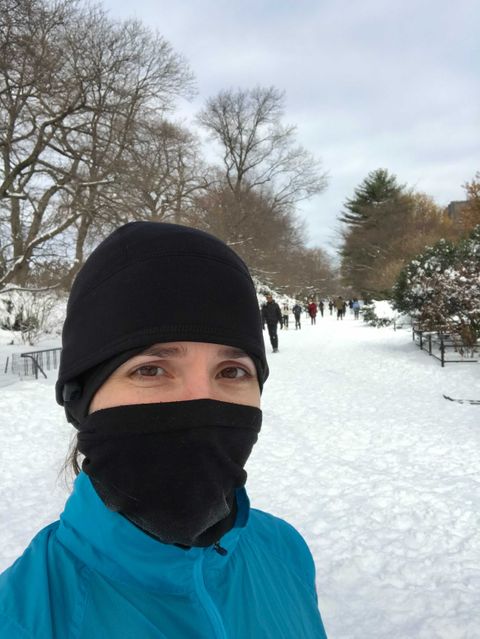
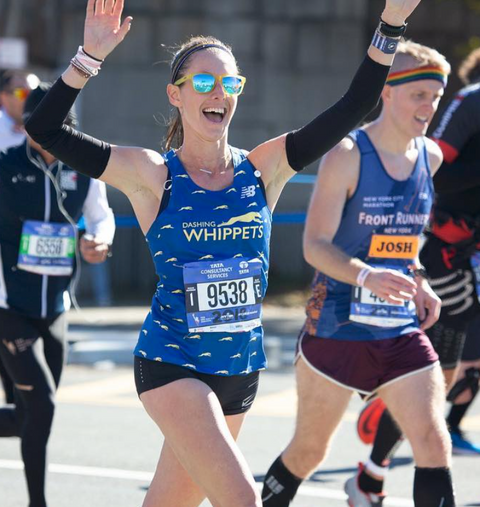
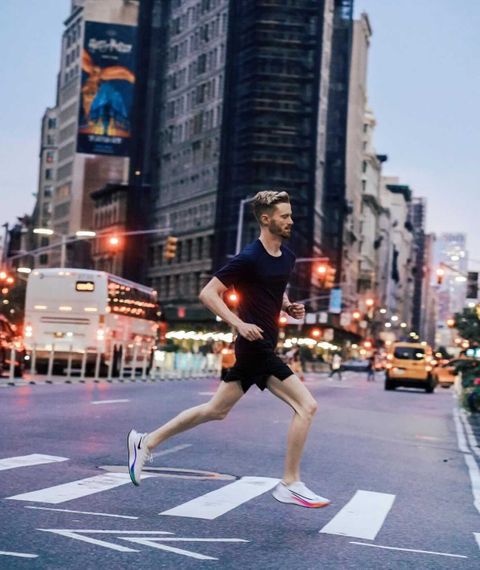

![We're streaming LIVE on Instagram! Although our coaches have lost their in-studio platform, they're working hard to keep us all connected! Consider donating...[read more] Welcome to a new kind of club](https://static.spacecrafted.com/dd5b319d20304631b44b4c04a39e9fa5/i/faddaa4c402e450fb52e859dcb83df16/1/4SoifmQp45JMgBnHiEPM6/MHRC_jul_11_19_noho_032.jpg)

